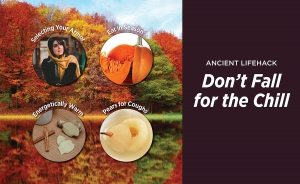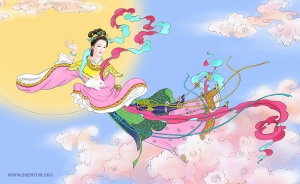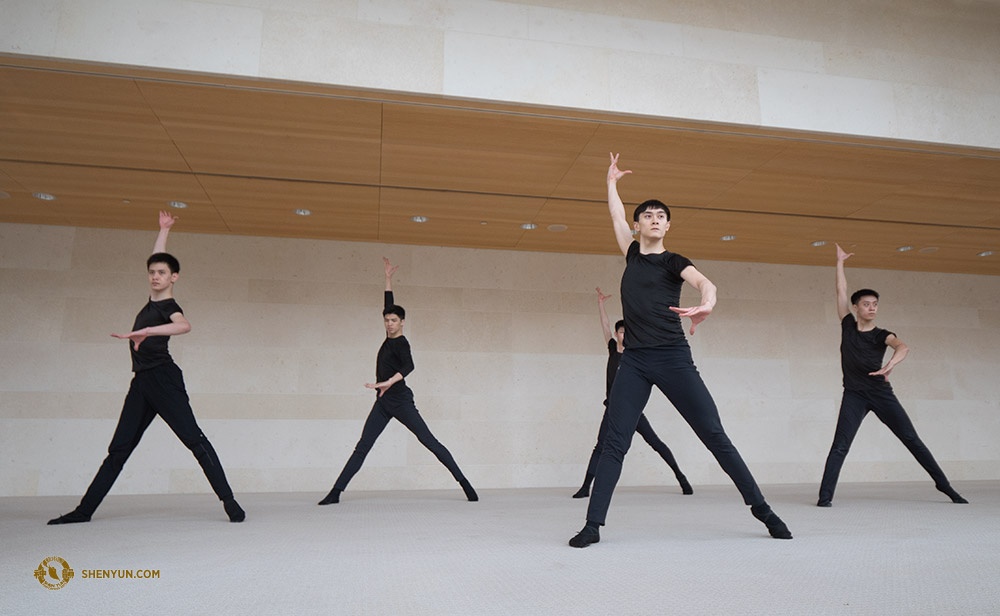
Diário da turnê
Uma postagem por dia de todos os dias da turnê. Há muito o que escrever? Teremos que descobrir. Por favor, deixe um comentário no final. Espero que goste!
- 25 de dezembro: Vamos para a estrada!
- 26 de dezembro: Noite de abertura
- 27 de dezembro: Recapitulação da estreia da temporada
- 28 de dezembro: Entre dois shows
- 29 de dezembro: É pouco de alongamento
- 30 de dezembro: Vista do fosso da orquestra
- 31 de dezembro: Vídeo de Feliz Ano Novo
- 1º de janeiro: Dois MCs, três idiomas em Montreal
- 2 de janeiro: O camarim ideal
- 3 de janeiro: Dia favorito
- 4 de janeiro: Foto de formação
- 5 de janeiro: Planos de amanhã
- 6 de janeiro: No menu
- 7 de janeiro: A perna misteriosa
- 8 de janeiro: Vídeo 'Banido na China'
- 9 de janeiro: O grande debate
- 10 de janeiro: O concertino
- 11 de janeiro: O vencedor do debate
- 12 de janeiro: O ritual do pôster
- 13 de janeiro: A despedida chinesa
- 14 de janeiro: Da Venezuela com amor
- 15 de janeiro: Top 8 maneiras de perder coisas
- 16 de janeiro: O quiosque do shopping
- 17 de janeiro: Em Detroit
- 18 de janeiro: Vídeo dos dançarinos pela neve
- 19 de janeiro: Reciprocidade
- 20 de janeiro: Emoldurado no saguão
- 21 de janeiro: Motor City
- 22 de janeiro: Perguntas e respostas do desafio de intervalo
- 23 de janeiro: A trombeta silenciosa
- 24 de janeiro: O ano novo chinês
- 25 de janeiro: Hora da entrevista?
- 26 de janeiro: 10 shows realizados
- 27 de janeiro: Ano novo a distância
- 28 de janeiro: Bem-vindo a Evansville
- 29 de janeiro: Trabalhando com música clássica
- 30 de janeiro: Hotéis mal-assombrados
- 31 de janeiro: Ratos sem fim
- 1º de fevereiro: Não é da China
- 2 de fevereiro: Prosa de Steven
- 3 de fevereiro: Uma revisão britânica
- 4 de fevereiro: Tosca no Shen Yun
- 5 de fevereiro: Em Madison/Coreia do Sul
- 6 de fevereiro: Obrigado, Kirk!
- 7 de fevereiro: Apresentando-se no Egito Antigo
- 8 de fevereiro: Festival das Lanternas
- 9 de fevereiro: Espacate perfeito
- 10 de fevereiro: Sem script
- 11 de fevereiro: Ouvimos você, Parte II
- 12 de fevereiro: Momento pessoal solitário
- 13 de fevereiro: Palco escuro
- 14 de fevereiro: Durões de Philly
- 15 de fevereiro: 'Back leg hold'
- 16 de fevereiro: Seu Rosemont
- 17 de fevereiro: A vez do Teo
- 18 de fevereiro: Escalada
- 19 de fevereiro: Regras para uma parada de descanso
- 20 de fevereiro: Condensação
- 21 de fevereiro: O duplo duplo
- 22 de fevereiro: 'Te peguei, baby'
- 23 de fevereiro: O Grande Dia
- 24 de fevereiro: Praia de Iowa
- 25 de fevereiro: Não apenas burros falsos
- 26 de fevereiro: Não estão acreditando
- 27 de fevereiro: Indo atrás de nós com um vírus?
- 28 de fevereiro: Caminhando para o Oeste
- 29 de fevereiro: a garota do PCC
- 1º de março: Titãs do tênis de mesa
- 2 de março: Uma perna feita
- 3 de março: Feito nos EUA
- 4 de março: Esperou 10 anos
- 5 de março: 305
- 6 de março: Dias fáceis
- 7 de março: Do outro lado do Butter Dome
- 8 de março: O Jubilee
- 9 de março: Comparar e contrastar
- 10 de março: Descubra a diferença
- 11 de março: Chapéu branco
- 12 de março: Última postagem?
- Roteiro para postar no Blog
- Um de nossos dançarinos principais gosta de dormir virado para cima em um espacate horizontal, pernas e braços estendidos 180 graus para o lado. Como você verá, o sono esticado é um tema comum.
- Uma variação comum disso é usada por muitos dançarinos para cochilar: eles ficam em um espacate lateral, então deitam de bruços e esticam os braços para os lados também. A maioria dos mortais não consegue nem chegar perto dessa posição, muito menos achar que é uma maneira relaxante de cochilar.
- Outro popular é o sono no espacate frontal, cabeça aos joelhos. Sabe-se que um dançarino adormeceu em um quarto de hotel fazendo um espacate frontal vertical, ou seja, uma perna contra a parede, apoiada na parede.
- Colchões duros são preferidos para o apoio das costas, e às vezes alguns dos rapazes simplesmente colocam suas roupas de cama no chão e dormem lá, deixando as camas macias frias.
- Alguns não usam travesseiros; outros arrumam todos os oito travesseiros de ambas as camas em algum tipo de formação de bunker de saco de areia.
- A maioria das mulheres não usa travesseiros, mas muitas trazem um bichinho de pelúcia.
- Alguns dançarinos têm mini umidificadores, especialmente para quartos secos de hotéis canadenses.
- Três cadeiras e uma camisa no rosto é um método típico.
- Arrastando os colchonetes para uma sala de troca rápida e cochilando, ai está outro.
- Uma vez no ano passado, uma dançarina pegou uma mala de fantasias vazia e usou-a como base para o torso e a parte superior do corpo, basicamente dormindo em uma mala com as pernas para fora.
- Outros têm esteiras de acampamento alemãs infláveis especiais.
- E depois há aqueles dançarinos que não dormem muito e ficam acordados depois de quatro horas ansiosos para ficar tontos.
25 de dezembro: Vamos para a estrada!
Feliz Natal e Feliz Hanukkah! Hoje também é o nosso grande dia—esta manhã nos despedimos de nossas famílias, colocamos coisas nos ônibus para cinco meses e pegamos a estrada. Pela primeira vez, três de nossas sete companhias partiram exatamente ao mesmo tempo—uma para Stamford, Connecticut, uma para Dallas, Texas, e estamos indo ao norte da fronteira para Ottawa. É uma linda manhã de Natal, céu azul e simplesmente adorável estar ao ar livre ou no ônibus. Noite de abertura amanhã—mal posso esperar!
26 de dezembro: Noite de abertura

Em algumas horas, este teatro estará cheio de pessoas e energia e emoção e dança e música e cores. Primeira preparação em turnê aqui no National Arts Centre em Ottawa e eu já aprendi algo novo—um teatro canadense usa uma vassoura de curling... Eles a usam para colar o piso de dança Marley.
27 de dezembro: Recapitulação da estreia da temporada

O primeiro show foi ótimo! É sempre bom começar e voltar a encarar o público dia após dia. O público aqui em Ottawa adorou especialmente algumas das histórias engraçadas e algumas das surpresas na projeção animada, assim como nossa soprano, Jiang Min. Uma ótima maneira de começar a turnê. Indo para o teatro agora para uma matinê.
28 de dezembro: Entre dois shows

Nosso primeiro dia de dois shows do ano. Agora estamos entre os shows, e neste momento os artistas podem ser divididos em dois grupos: aqueles que primeiro cochilam, depois meditam; e aqueles que primeiro meditam, depois cochilam.
29 de dezembro: É pouco de alongamento

Acabo de chegar a Hamilton depois de uma viagem chuvosa por Ontário. O que os dançarinos do Shen Yun fazem assim que chegam ao hotel depois de horas no ônibus? Pegam qualquer móvel que puderem encontrar e se alongam.
30 de dezembro: Vista do foço da orquestra

Um novo dia em um novo teatro, bem teatro aqui: FirstOntario Concert Hall em Hamilton. A cada novo local, além da preparação e passagem de som, a orquestra ensaia com os dançarinos. O maestro Milen Nachev está de olho na orquestra e na ação que ele deve combinar no palco.
31 de dezembro: Vídeo de Feliz Ano Novo
Véspera de Ano Novo... e acabamos de terminar uma apresentação matinê em Hamilton, Ontário. É uma tradição do Shen Yun que todos os artistas participem em atacar após uma apresentação—desmontando o palco, empacotando as roupas e o equipamento e carregando o caminhão. Isso nos permite encerrar rapidamente e sermos super móveis, chegando a mais cidades em turnê. Também mantém todos, mesmo as maiores estrelas, humildes.
O ataque de hoje parece muito festivo. Afinal, acabamos de completar o último show do ano. Em breve, os artistas estarão em seus telefones ligando para a família em casa e amigos em outros grupos ao redor do mundo. Mas, primeiro, eles têm uma mensagem para vocês no vídeo: Feliz Ano Novo! Que você e os seus tenham um 2020 maravilhoso, seguro e significativo!
1 de janeiro: Dois MCs, três idiomas em Montreal
Acabei de chegar na bela Montreal. Um pouco de nevasca no caminho, mas no geral tivemos um clima excelente para um inverno canadense até agora.
Sempre que trocamos de cidade e local, isso pode realmente afetar um pouco. Uma diferença de alguns metros na largura do palco pode alterar as formações de dança. O tamanho e a forma de um fosso de orquestra influenciam como os músicos ouvem uns aos outros.
Para os MCs, o Leste do Canadá apresenta um conjunto único de desafios.
Em Ottawa, falamos principalmente inglês. Mas por ser a capital e perto das regiões de língua francesa, incluímos também um pouco de francês e, sendo uma produção chinesa, tínhamos que ter chineses. Portanto, o roteiro era algo como 50% inglês, 25% chinês, 25% francês. Então, para Ottawa, fiz parceria com Catherine Fang, que fez o francês, enquanto fiz a maior parte do inglês em chinês.
Depois, em Hamilton, reencontrei minha parceira regular, Alice Liu, e fizemos o script inglês-chinês de costume.
Agora, na Montreal, predominantemente de língua francesa,, Catherine estará de volta ao palco e, desta vez, o roteiro será 50% francês, 25% inglês e 25% chinês.
O desafio de dizer três roteiros diferentes em três cidades consecutivas para começar a turnê é manter o controle de qual versão você deve dizer quando.
Lembro-me da primeira vez que fizemos um roteiro trilíngue. Foi muito ad hoc. Foi nossa primeira apresentação em Montreal no início de 2007, e eu estava a apenas 10 dias de me tornar um MC profissional. Minha parceira e eu tínhamos preparado um roteiro em francês e chinês, com ela fazendo o francês e eu fazendo as partes chinesas. Então, durante o intervalo, o apresentador local veio até nós nos bastidores. "Sinto muito", disse ele, "mas temos muitos membros da audiência que vieram de uma cidade próxima onde, na verdade, só falam inglês e estão tendo dificuldade em acompanhá-lo. Você poderia acrescentar um pouco de inglês?"
Poucos minutos antes do início da segunda parte, não tivemos tempo de reorganizar tudo o que íamos dizer. Não tivemos tempo para ensaiar. Então, nos segundos antes de entrar no palco a cada vez, olhávamos um para o outro e diríamos: "Ok, eu-inglês, você-francês, eu-chinês, eu-inglês, você-francês, eu-inglês. Vá!" E assim continuamos.
Apresentações trilíngues agora são uma parte comum de nossas apresentações, não apenas no Canadá. Enquanto escrevo isso, outro de nossos MCs está fazendo o mesmo no Japão e outro na Suécia. Fazemos isso há anos. Mesmo assim, é melhor eu ter uma boa noite de sono.
2 de janeiro: O camarim ideal
Agora estamos nos preparando para nossa primeira apresentação na recém-reformada Place des Arts. Enquanto a orquestra e os dançarinos ensaiam e eu tenho um momento de silêncio no camarim, percebo que eles realmente se esforçaram nos camarins. Se alguém precisava de um modelo do que um camarim deveria incluir, esse é o camarim—compartilhado pelo maestro e por mim.

Ele começa com o código na porta para segurança extra. Entre em uma ampla sala de última geração, preparada para duas pessoas, com (no nosso caso) prateleiras para fantasias, duas bancadas de granito, dois conjuntos de espelhos emoldurados por luminárias, divididos por outro espelho acima da pia. A torneira cromada permite que você controle a água quente (o que você definitivamente não pode desvalorizar com todas aquelas torneiras ativadas por sensor que ajudam a economizar água, mas não ajudam a barbear). O banheiro recém-reformado possui uma pia separada (com o sensor) que permite o uso duplo de pias em momentos críticos antes do show, bem como um chuveiro e ladrilhos de carvão. O chão é acarpetado em um sutil tema retro dos anos 70. Armários Califórnia e uma elegante mesa de centro de vidro combinam com o sofá exuberante que tem o comprimento certo para se deitar. Um dial modera o volume do feed do palco, e um enorme relógio digital vermelho torna impossível não saber quando é a hora de estar em algum lugar. Por fim, um piano, embora desperdiçado comigo, torna-o uma sala perfeita para o nosso maestro, que é conhecido por compor novas melodias enquanto apenas tocava no camarim Yamaha. Quero embalar este camarim e levá-lo conosco na turnê.
3 de janeiro: Dia favorito
A maioria das pessoas tem um dia favorito na turnê. Provavelmente o dia de folga é popular (ou talvez universal). Não há muitos deles, portanto, é melhor não se apegar muito.
Nunca ouvi ninguém dizer que seu dia favorito é o dia da preparação. Dependendo do seu papel, esses dias podem durar 16 horas—desde a chegada mais cedo ao teatro até a passagem de som, os ensaios, uma apresentação e o retorno ao hotel. O maior dia de preparação é o dia de preparação-apresentação-ataque. Esses podem acontecer algumas vezes por temporada e, para os envolvidos na produção, vai das 7h30 à meia-noite. Falando historicamente, tivemos até um punhado de dias de preparação-duas apresentaçoes-ataque. Esses gigantes geralmente envolviam entrar no teatro à 1h da manhã, preparar até por volta do meio-dia, fazer duas apresentações, seguido de ataque. Lembro que fizemos um em Praga e outro em Dublin, que foi seguido por uma recepção VIP após o segundo show. No momento em que estávamos conversando com os dignitários nesta recepção, não tínhamos ideia do que estávamos tagarelando.
Também nunca ouvi ninguém dizer que gosta mais dos dias de viagem. Mas talvez haja uma pessoa assim por aí.
Alguns preferem os dias de dois shows. E para aqueles em nossa companhia que gostam, eles podem aproveitar um dia como esse amanhã. Essas pessoas dizem que gostam da simplicidade de um dia que gira inteiramente em torno da apresentação, e da alegria de interagir tanto com o público.
Outros podem gostar dos dias de uma apresentação à noite. O dia vai crescendo lentamente em direção ao grand finale.
Meus favoritos são os dias com um show à tarde. Levantar cedo. Tomar café da manhã ou ir para a academia. Ir ao teatro e preparar para o show. Ter um almoço rápido. Ir para o palco. Depois, jantar mais cedo, o que acho um bom motivo para comer um pouco mais. E então, uma noite agradável e relaxante que pode ser passada com amigos, explorando uma nova cidade, apenas relaxando no hotel, ou mesmo sendo produtivo em uma cafeteria. Hoje foi esse tipo de dia.
Bônus: por alguma razão, nossas sextas-feiras até agora no Canadá têm oferecido matinês, não apresentações noturnas. Tradicionalmente, nossos fins de semana apresentavam shows na sexta-feira à noite, dois no sábado e um à tarde no domingo. Apesar de ser sexta-feira à tarde, os teatros estão lotados e muito animados. Talvez alguém possa me dizer qual é o motivo. Mas não me entenda mal, eu adoro isso.
4 de janeiro: Foto de formação

Antes da nossa segunda apresentação de duas hoje em Montreal, os dançarinos se aquecem no palco. A coisa bonita sobre esta foto (cortesia do dançarino Ben Chen), é que eles não estavam posando para uma foto, eles apenas estavam se alongando em formação. A partir da esquerda: Jun Liang, Rubi Zhang, Shawn Ren, Bill Hsiung e Teo Yin.
5 de janeiro: Planos de amanhã
Com os gritos da plateia na chamada da cortina, terminamos nossa última apresentação em Montreal. Menos de duas horas depois, já estávamos indo para o oeste para Mississauga. A dançarina Betty Wang tinha acabado de postar um blog sobre como nosso clima canadense tem sido ameno, então é claro que pegamos uma tempestade de neve no meio do caminho, o que acrescentou mais uma hora à viagem de cinco horas. Não estou dizendo que é culpa dela. Eu não estou dizendo que não.
Amanhã será nosso primeiro dia de descanso desde que partimos para a turnê na manhã de Natal. Alguns de nós assistiremos ao novo filme do Star Wars. Alguns dançarinos ainda estão debatendo se ao vão laser tag ou arco e flecha. Alguns comerão uma grande salada no Whole Foods. A maioria vai dormir. Os bailarinos ainda terão seus treinos, e alguns músicos literalmente aproveitarão o dia e não o deixarão passar, praticando por horas a fio. Nossa harpista estava tentando descobrir uma maneira de tirar a harpa do caminhão (estacionado em outro lugar) e colocá-la no hotel. Para os violinistas é muito mais fácil.
6 de janeiro: No menu
Onde quer que vamos, o apresentador local oferece deliciosas refeições preparadas para nós, muitas vezes com especialidades caseiras. Conseguir o suficiente para comer durante a turnê não é o problema, muito pelo contrário. NO ENTANTO, o que acontece quando você pega um grupo de pessoas que todos os dias recebe sua comida e lhes dá um dia de folga para escolher o que comer por conta própria?
Fui ao Whole Foods e comprei uma salada enorme. Eu complementei com tofu, falafel e, claro, macarrão com queijo. Aqui está uma pequena pesquisa sobre o que nossos membros da ORQUESTRA tiveram hoje:
Hambúrgueres Big Smoke Burger
Macarrão de carne de Lanzhou
KFC
Comida indiana no Amaya
Salada com molho chipotle
Peixe e batata frita
Arroz roxo com bulgogi coreano e vegetais
Macarrão instantâneo….
Enquanto isso, os dançarinos fizeram seu treino físico hoje correndo para o shopping, pois era muito perto para pegar Uber, muito frio para caminhar sem pressa.
No geral, um raro dia relaxante e de volta aos treinos amanhã.
7 de janeiro: A perna misteriosa
Acordei cedo esta manhã e vi uma perna na parede. Meu colega de quarto, um dançarino, estava de cabeça para baixo em sua cama, a perna esquerda esticada contra a parede e apontando para o teto; a perna direita não sei ao certo onde. Ele estava dormindo profundamente.
Enquanto eu escovava meus dentes e me perguntava se minha escova de dentes com sua nova bateria estava tão barulhenta que iria acordá-lo, ou talvez não fosse tão barulhenta se eu não usasse minha boca para imitar a alavanca de uma guitarra, também ponderei se todos os dançarinos têm formas incomuns de dormir. Algumas mensagens de texto depois, tenho uma resposta para você:
Não, mas alguns sim.
A maioria dorme normalmente, inserindo-se entre os lençóis seguros do hotel e, quando os lençóis estão muito apertados, tentando não puxar o tendão da coxa enquanto eles os chutam. Mas alguns dançarinos são um pouco mais exclusivos:
Cochilar no teatro tem seu próprio conjunto de truques:
Falando nisso, meu colega de quarto se juntou a nós no saguão, pronto para ir ao teatro para o treinamento em um dia sem show. Deixe-me pedir sua permissão para postar isso.
8 de janeiro: Vídeo 'Banido na China'
Hoje, quando fizemos nosso primeiro show em Mississauga, uma entrevista que fiz pouco antes da turnê com o American Thought Leaders em Nova York foi transmitida ao mesmo tempo:
"Shen Yun Destrói Narrativas do Partido Comunista, Incitando Ataques pelo Regime da China"
Aqui está, se você estiver interessado. Aparentemente, algumas pessoas não sabiam que o Shen Yun não era propaganda do governo chinês. Assim que descobriram que o PCC está contra nós e tem tentado nos sabotar todo esse tempo, eles decidiram que deveriam ver o show e foram comprar ingressos.
9 de janeiro: O grande debate
“O violoncelo representa o homem ou o pai?”, nosso concertino me perguntou. Parece que ele estava no meio de um debate com outro músico, talvez um violoncelista, e precisava de um árbitro.
“Sobre o que estamos conversando?”, perguntei.
“Sabe no trio, entre o jovem taoísta, a jovem com lenços e o pai dela? O violino representa a jovem, mas há um violoncelo e uma viola representando dois homens. Então, quem é quem?”
Ok, agora eu sabia a que ele está se referindo — em nossa segunda metade, temos uma história em que um jovem taoísta, que é uma espécie de bruxo amigável, tem um instrumento mágico que pode fazer qualquer coisa do nada. Ele divertidamente o usa para tirar uma jovem de uma situação difícil. Os dois então descobrem que têm um vínculo espiritual.
Junto com seu pai solidário, um pequeno trio se segue. Os instrumentos solo são violoncelo, viola e violino, realizado pelo nosso concertino.
Mas as vozes de quem os instrumentos estão soando? O violino mais leve é certamente a jovem ágil com longas tranças. Mas o violoncelo mais profundo é o jovem taoísta, cheio de profundidade e sabedoria introspectiva? Ou talvez seja a viola, um instrumento de gama média, que representa o taoísta e o equilíbrio que encontrou com o Caminho do universo? Nesse caso, talvez o violoncelo represente o pai idoso, seus tons ricos ressoando com a profundidade de sua experiência de vida.
Ou não representam nem um nem o outro, e como dois ou três sons se fundindo como um, eles representam almas se unindo em um momento de predestinação taoísta?
Voltarei para você com algumas respostas no sábado.
10 de janeiro: O concertino
(Esta postagem é uma continuação do tópico de ontem, então se você ainda não leu, você pode rolar para baixo para ver primeiro e depois voltar.)

Então, em troca da minha participação no debate que começou ontem, o concertino concordou em nos contar um pouco sobre o que um concertino realmente faz. O papel pode ser óbvio para qualquer pessoa que já tocou em uma orquestra clássica, especialmente na seção de cordas. Mas essa não é a maioria de nós. Então, aqui está uma breve visão geral:
O concertino é como uma ponte entre o maestro e o resto da orquestra, começando com as cordas. Ele comunica os desejos do maestro para interpretar a música e como ela deve soar.
O concertino se senta imediatamente à esquerda do maestro. É por isso que a posição também é chamada de "primeira cadeira". Na Itália, o concertino é realmente chamado de la spalla, que significa ombro. Isso porque o concertino é a pessoa na qual o maestro pode, metaforicamente e literalmente, apoiar-se.
Ele ou ela — ele neste caso — é o encarregado de conduzir as seções de cordas ou, mais precisamente, de conduzir a primeira seção de violino.
Nos primeiros dias da orquestra sinfônica na Europa, não havia nem mesmo um regente separado — o concertino conduzia a orquestra.
O concertino normalmente toca todos os solos de violino na apresentação.
O concertino freqüentemente fornece decisões sobre o arco para uma nova música, de modo que toda a seção de cordas toque em uníssono.
Em apresentações sinfônicas, como a Orquestra Sinfônica do Shen Yun, o concertino, geralmente Chia-Chi Lin ou Astrid Martig, sobe no palco depois do resto da orquestra, mas antes do maestro, recebendo uma salva de palmas personalizada.
O concertino conduz a afinação da orquestra antes de uma apresentação. Isso não é apenas uma formalidade, mas uma preparação importante para o show. Se o concertino ouvir uma seção ou um instrumento desafinado, ele pode pedir-lhes para repetir a nota e corrigi-la.
E, logo antes de a apresentação começar, nos segundos finais antes de a cortina subir, depois que os holofotes do maestro acenderem e ele se levantar, o concertino e o maestro apertam as mãos. É um sinal de respeito mútuo entre o maestro e a orquestra, sendo o concertino um representante de todos os músicos.
Você pode ver por que o concertino tem que ser um dos músicos mais habilidosos da orquestra, um líder e músico forte com gestos de arco claros, um violinista com boa musicalidade e timing impecável, e alguém que pode ajustar e responder rapidamente, especialmente em uma performance que envolve sincronizar com os dançarinos no palco.
Com as sete orquestras do Shen Yun, temos sete concertinos, cada um com uma história pessoal muito diferente. Tseyu Chang do nosso grupo está agora em seu segundo ano como concertino. Nascido em Taiwan, ele está com o Shen Yun desde sua fundação em 2006 e já tocou em mais de 1.400 apresentações como parte da produção de dança, bem como oito anos com a Orquestra Sinfônica do Shen Yun, incluindo no Carnegie Hall e outras salas famosos de concertos em todo o mundo.
Mesmo assim, ele quer saber nossa opinião — o violoncelo é o taoísta e a viola o pai, ou o contrário? Terei que assistir e ouvir novamente esta noite durante a apresentação e entrar em contato com você.
11 de janeiro: O vencedor do debate
Tudo bem, eu tenho uma resposta para você para a pergunta abaixo (9 de janeiro).
Estou escrevendo para você do camarim aqui em Mississauga, Canadá, digitando baixinho para não acordar o maestro que cochila. Estamos entre duas apresentações no doubleheader padrão de sábado. Esta tarde, notei que o público aqui tinha um grande olho para os detalhes — eles estavam acompanhando todas as pequenas sutilezas da performance de perto e reagindo instantaneamente. Foi muito divertido.
Para não ficar atrás do nosso público, prestei atenção especialmente em como a música e a dança combinavam em uma história na segunda metade, e como os três personagens — homem taoísta, a jovem e o pai da jovem — alinhados com três instrumentos — violoncelo, violino e viola. E sim, depois de seguir os dançarinos nos bastidores, monitorando eles no palco, olhando e ouvindo com atenção, tenho uma resposta. A viola é o pai, o violoncelo é o taoísta e o violino é a jovem.
Sem fazer uma chamada para um compositor (pois isso seria trapaça), aqui está a evidência à minha disposição:
Já estabelecemos que o solo de violino leve representa a jovem de longas tranças. O concertino ontem me disse isso.
O tema do jovem cavalheiro taoísta, não exatamente um leitmotiv, mas claramente reconhecível, é tocado pelo violoncelo mesmo mesmo após o trio terminar e o pai recua para o fundo para o dueto entre sua filha e o taoísta.
Isso deixa apenas a viola para representar o pai. E, se você pensar bem, faz todo o sentido. O pai é um personagem entre os dois jovens parceiros e suas aspirações espirituais correspondentes de buscar o Caminho. Ele é solidário, mas é principalmente um intermediário que os apresenta e os abençoa. E entre os dois instrumentos de cordas do violoncelo e do violino, existe apenas a viola.
Levei apenas 15 shows para descobrir isso.
12 de janeiro: O ritual do pôster
Domingo à tarde e estamos bem antes de nossa sexta e última apresentação em Mississauga. Muitos corredores dos bastidores são enfeitados com pôsteres, geralmente assinados, de artistas e companhias que atuaram lá. Alguns são históricos — grandes lendas que mal foram capturadas nem mesmo em vídeo, e outros são mais contemporâneos.

Aqui em Mississauga, é como uma homenagem ao Shen Yun.
Conforme você caminha pelo longo corredor que corre paralelo à parede posterior do palco, um lado inteiro é coberto com pôsteres do Shen Yun de todos os anos desde que nos apresentamos aqui pela primeira vez em 2012 — cada um autografado por toda a companhia daquele ano.
Isso leva a um pequeno ritual enquanto os artistas, geralmente nos momentos livres após uma refeição, vagueiam para olhar as assinaturas. Eles procuram seus próprios autógrafos. Eles procuram amigos em outros grupos. Eles se lembram de pessoas com quem fizeram turnê cinco, seis, sete anos atrás. Eles encontram pessoas que já se aposentaram ou partiram e passaram a fazer outras coisas. Explosões do passado, suponho que não seja diferente de olhar os anuários de classe.
E, claro, há a assinatura do novo pôster. Alguns adicionam um pequeno brilho — um mini desenho de sua viola ou um local divertido para assinar um nome, como no pé do dançarino retratado. No ano que vem, mais um de nossos grupos vai adicionar os deles à coleção, em um pôster a ser definido, para uma apresentação a ser criada.
13 de janeiro: A despedida chinesa
É bom estar de volta ao sul da fronteira. Cruzamos a ponte Ambassador de Windsor, Ontário, sobre o rio Detroit e entramos em Michigan. Esta é uma das passagens de fronteira mais movimentadas na América do Norte, e a segurança era particularmente pesada hoje. Mais duas horas e um bufê nipo-chinês depois, chegamos ao nosso hotel em Grand Rapids. Amanhã teremos um daqueles dias intensos de preaparação-apresentação-ataque. Este pode ser o único da nossa companhia este ano, embora no passado os tivéssemos o tempo todo.
Esta manhã, quando partimos de um hotel no Canadá, os apresentadores locais e voluntários vieram para se despedir. Quando nosso ônibus amarelo brilhante dobrou uma esquina e parou em um sinal vermelho, avistei um chinês que ainda estava parado ali, olhando para nós, a alguns quarteirões de distância. Ele não estava acenando, como havia feito alguns momentos antes, pois já tínhamos ido embora. Ele estava literalmente se despedindo de nós.
Os chineses têm essa tradição que achei muito tocante na primeira vez que a experimentei. Quando eles se despedem de alguém, digamos, um convidado em sua casa, eles ficam lá e observam a pessoa ir embora até que o carro desapareça à distância. Isso às vezes leva a uma dancinha de adeus, em que a pessoa vai embora, depois se vira para olhar para trás e acena, depois segue em frente, para o carro e acena de novo e finalmente desaparece. Essa mesma cena de despedida também pode ser representada em outros ambientes — se levarem alguém até uma estação de metrô, por exemplo, eles ficarão no degrau mais alto até que a pessoa desapareça inteiramente por baixo.
Talvez muitas outras culturas também façam isso. Nós definitivamente vimos ou fizemos esse tipo de coisa em aeroportos, certo? E está nos filmes nas estações de trem ou quando um navio transatlântico sai do porto. E está nos romances, onde amigos caminham uns aos outros até a periferia da vila, relutantes em se separar.
Mas nunca vi isso ser feito tão constantemente, mesmo na ocasião mundana de deixar um colega em casa, como aconteceu com meus amigos chineses.
O que me traz de volta ao homem de jaqueta azul e boné de beisebol preto olhando para cima parado em uma luz vermelha eterna. Ele fazia parte da equipe encarregada de vigiar nossos veículos 24 horas por dia. Temos esse tipo de segurança para nossos veículos desde que alguém, e achamos que sabemos quem, tentou sabotá-los em uma série de cortes de pneus e adulteração do tanque de combustível alguns anos atrás. Daquele dia em diante, inúmeros voluntários ao redor do mundo, muitos deles chineses que não falam inglês, ficaram sentados em seus carros estacionados a noite toda observando nossos ônibus. E fazemos turnê durante o inverno. No Canadá.
Eles fazem isso em apoio ao Shen Yun e ao que fazemos. Eles não querem nenhum reconhecimento. Eles se revezam, então nem mesmo vemos os observadores noturnos. Eu nunca, em todos esses anos, ouvi nenhum deles reclamar. Mas vi seus narizes frios e vermelhos e bochechas secas pelo vento quando eles se despediram de nós. E eu vi o homem parado ali sozinho. Tentei acenar para ele, mas ele não conseguia me ver dentro do ônibus. Estávamos indo para a próxima cidade, e ele voltou para sua família e para pôr em dia o trabalho perdido depois de uma semana de férias protegendo nossos ônibus, e não querendo dizer adeus.
14 de janeiro: Da Venezuela com amor
Conheça Gustavo Briceño. Violinista, este é seu terceiro ano com o Shen Yun. Sua esposa, Gabriela Gonzalez-Briceño, é fagotista do Shen Yun. E eles viajam pelo mundo juntos — em companhias separadas. Deixe-me explicar.

Gustavo e Gabriela são venezuelanos, onde já haviam embarcado em destacadas carreiras musicais antes de ingressarem no Shen Yun, juntos, em 2017.
Como você provavelmente sabe, o Shen Yun atualmente tem sete companhias que fazem turnês pelo mundo ao mesmo tempo. Gustavo sempre esteve em nosso grupo — Shen Yun World Company. Gabriela está com a orquestra do Shen Yun International Company. Estamos em Grand Rapids, Michigan. Eles estão em Manchester, na Inglaterra. Mas eles estão sempre juntos.

Aqui está uma foto de Gustavo no almoço. Isso é o que ele faz—seu fone de ouvido está constantemente conectado a pelo menos um ouvido. É a mesma coisa quando ele entra no ônibus pela manhã. É a mesma coisa quando ele está na academia. É a mesma coisa quando ele está ajudando a empacotar depois de um show.
Ele não é uma daquelas pessoas que está sempre ouvindo podcast ou música clássica, ou usa fones de ouvido apenas para evitar humanos reais. Ele parece ter apenas uma linha telefônica aberta constante com sua esposa. No casamento, comunicação é tudo, certo?
E se você se sentar ao lado dele no almoço, não parece que ele está sendo anti-social. Ele está envolvido na conversa da mesa. É que ele está tendo outra conversa paralela em espanhol em seu fone de ouvido. É como se sua esposa estivesse lá, ao seu lado, lhe fazendo companhia. Presumivelmente, alguém no mundo paralelo de seu grupo está escrevendo um blog sobre ela falando com Gustavo.
E se você está se perguntando por que não colocar os dois no mesmo grupo. Bem, também temos casais assim. Não tantos, realmente, mas alguns. E se todos eles estivessem nos grupos uns dos outros, seria administrativamente difícil, se não impossível.
Por exemplo, Gabriela toca fagote. Mas o fagote da nossa orquestra é casado com um dos percussionistas dessa orquestra, então você teria que realocar os dois para outra companhia para trazer a Gabriela aqui. Fica complicado super rápido.
E então há o argumento de que vocês podem gostar de estar juntos quando estão em casa, e em turnês você pode se concentrar em sua arte e atuação. Somos uma grande família de qualquer maneira, e há muito apoio e carinho para todos.
Além disso, na minha experiência, estar ausente metade do ano é uma boa fórmula para um casamento longo e feliz: sair para a turnê antes de esgotar suas boas-vindas, voltar quando você sentir falta o suficiente.
Ou apenas fale muito ao telefone.
15 de janeiro: Top 8 maneiras de perder coisas
Ontem foi só um e pronto em Grand Rapids. Isso também significa apenas uma breve estadia no hotel aqui antes de ir para Detroit esta manhã. Eu percebi uma lei cósmica de que há uma correlação inversa entre o quão bom um hotel é e quanto tempo você fica lá. Chame isso de Lei de Fawlty.
Todos os hotéis em que nos hospedamos hoje em dia são muito bons, mas às vezes há aquele que é tão perfeito que tem até recarga de celular sem fio, omeletes deliciosas e uma academia decorada. Então, em um hotel tão perfeito como este, podemos ficar no máximo duas noites.
E é nessa combinação de estadias curtas em hotéis e estadas de um dia em um teatro que é mais fácil perder coisas. Ontem à noite, durante o intervalo, uma das carteiras de nosso violista (temos mais de um violista, mas cada um tem apenas uma carteira) foi relatada como roubada. Quando todos estavam prestes a verificar rapidamente seus objetos de valor, ele a encontrou.
É tão fácil perder coisas em turnê. E se você é novo nessa habilidade, aqui estão as top 8 maneiras para você começar:
1. Quando você chegar ao seu quarto de hotel, desfaça sua mala e coloque tudo em todas as diferentes gavetas da cômoda, gavetas do criado mudo, gavetas da mesa e qualquer compartimento possível que você encontrar. Na manhã seguinte, acorde tarde e faça o check-out com pressa.
2. Esconda seu passaporte muito, muito bem.
3. Vá para a plateia vazia à tarde e fique confortável, tire a touca e o cachecol e coloque-os no assento ao seu lado. Lembre-se deles uma semana depois.
4. Ouça música em seus Apple Airpods enquanto está deitado na cama. Em seguida, observe-os desaparecer nas almofadas fofas brancas, para nunca mais serem vistos.
5. Quando o ônibus parar em um posto de gasolina, pegue o carregador do telefone e conecte-o atrás de uma máquina de venda automática. Depois vá ao banheiro e, como a fila é muito longa, volte correndo para entrar no ônibus. Se apenas os ônibus tivessem carregamento sem fio.
6. Sempre que você sair do seu quarto de hotel, confie que a porta fechará sozinha atrás de você. Não se preocupe em puxá-la atrás de você, ouvir a trava, testá-la empurrando para trás ou qualquer coisa parecida. Definitivamente, deixe sua carteira em algum lugar visível.
7. Ao sair correndo do hotel atordoado pela manhã, pegue seu café da manhã, um casaco e coloque a chave do hotel em algum lugar. Quanto mais vago, melhor.
8. Deixe seus sapatos de dança fora do parapeito da janela do hotel durante a noite para arejar. Isso funciona melhor em Chicago.
(Obrigado à dançarina Betty Wang por contribuir para esta lista! Ela contribuiu como repórter, quero dizer, não com base na experiência pessoal. Pessoal, sim, mas não coisas de sua pessoa.)
Na verdade, a maioria de nós fará turnês inteiras seguidas sem perder nada. Mas então há algumas pessoas, e não vou nomeá-los aqui, todos nós sabemos quem são, que têm um talento especial para essa habilidade. Eu tenho uma lista dessas pessoas, agora onde eu coloquei…
16 de janeiro: O quiosque do shopping
No caminho de Mississauga para Detroit, uma de nossas viagens mais curtas do ano, paramos no Twelve Oaks Mall em Novi, Michigan. Esta é uma tática comum em deslocamentos locais. Se você precisa fazer check-out do seu hotel até as 11 e não pode fazer check-in no próximo antes das 3, e a viagem é de apenas algumas horas... vamos ver, 11 mais três, carregue o 1, voltar para o sistema de 12 horas am/pm, menos 2, adicionar para o tráfego, sair... algum tempo. Então, por que não parar em um shopping para almoçar no caminho?
Foi aqui que encontrei algo me chamando: um quiosque de vendas de ingressos do Shen Yun desocupado.

Este estava muito bom. Tinha alguns pôsteres grandes, panfletos e uma tela reproduzindo o trailer em loop. Mas não havia ninguém lá. Então, não muito diferente de Cachinhos Dourados, eu entrei imediatamente. Havia uma cadeira — não muito macia, não muito dura, apenas certa. E uma mesa, nem muito alta nem muito baixa.
Assim que me acomodei, uma senhora se aproximou. Impecavelmente vestida e caminhando com um andar elegante, ela parecia a frequentadora de teatro perfeita. "Com licença", disse ela com o que agora vou lembrar como um sotaque britânico. "Por acaso você sabe onde J.Crew está?". Esse era um tema recorrente, já que, de lado, o quiosque parecia uma tenda de informações. Eu educadamente redirecionei as pessoas na direção do diretório a alguns passos de distância.
Uma senhora disse que há anos queria ver esse espetáculo, perguntou sobre horários específicos, pegou um panfleto e disse: "Talvez eu te veja lá”. Mal sabia ela…
Então, três músicos vieram, prontos para me desafiar. "Olá, senhor, gostaríamos de saber mais sobre esta apresentação”.
"Com certeza! Escutem", eu disse, "posso conseguir um acordo especial para vocês! Bancos no nível da orquestra, bem perto do palco. Excelente vista do maestro. Experiência de som surround. Além disso, podemos providenciar viagens de ônibus gratuitas ida e volta para o teatro, uma refeição chinesa pré-show e uma refeição servida pós-performance. Vocês ainda terão a oportunidade de se misturar com alguns dos artistas e ficar com eles no mesmo hotel!".
De alguma forma, eles não compraram os ingressos e eu fui para a praça de alimentação.
17 de janeiro: Em Detroit
Primeira apresentação em Detroit esta noite. Estaremos aqui por cerca de 10 dias e fazendo 10 shows, o período mais longo em Detroit que me lembro. É na bela Detroit Opera House, com um saguão como o Palácio de Versalhes, camarotes como o Teatro alla Scala e um backstage como o Alcatraz. Os camarins, onde os solistas como a nossa soprano ficam, foram de fato projetados para os Sopranos — vagamente iluminado, poltronas de couro preto com tachas de ouro, fotos da famiglia nas paredes...
Eu estou brincando. É um belo teatro construído em 1922 que une a antiga glória de Detroit e o renascimento contemporâneo, completo com cafés descolados nas proximidades. Tentaremos conseguir algumas fotos.
Nos instalamos e fizemos a maior parte de nossa preparação ontem. Alguns teatros requerem apenas mais tempo. Não vou aborrecê-lo com os detalhes, mas direi que envolvia escadas. Muitas e muitas escadas.
Hoje iremos ao teatro na hora do almoço, faremos uma passagem de som e espaçamento do palco à tarde, e nos prepararemos para cumprimentar o público esta noite. Talvez a senhora do shopping (veja o post de ontem) esteja lá.
18 de janeiro: Vídeo dos dançarinos pela neve
Bom dia de Detroit. É assim que nosso dia começa antes de dois shows. Para todos os membros do nosso público que vêm ao teatro, e todos os outros lá fora: dirija com cuidado e fique aquecido. Esperamos vê-lo dentro do aconchegante teatro.
19 de janeiro: Reciprocidade
Às vezes, pequenos momentos me mostram que o universo é gentil.
Esta tarde, eu estava me barbeando antes do show. Eu sempre espero até o último minuto porque minha barba cresce tão rápido que tenho uma barba por fazer por volta das nove da manhã. Enquanto ensabouo, tenho um lugar sobrando para cobrir. Uma última gota de gel de barbear sai da lata. É isso aí. Eu agito a lata — está vazia. Meio ano usando essa lata, e ela esvaziou depois de fornecer apenas a quantidade certa pela última vez. E quando esvaziou? Na primeira vez em toda a turnê, temos uma viagem para Target agendada após o show.
Um eu cínico poderia esperar que esvaziasse há alguns dias, deixando-me correndo para cima e para baixo nos corredores brandindo uma navalha com o rosto meio espumado. Ou podia esvaziar amanhã, um dia depois de irmos às compras sem que eu percebesse que estava acabando. Ou poderia ter apenas uma gota a menos. Ou uma gota a mais. Não. Foi simplesmente perfeito. E isso chega em um momento em que estou procurando conscientemente o lado positivo das coisas.
E isso me faz pensar sobre o que escolhemos ver e notar. Já ouvi pessoas chamarem um fenômeno semelhante de lei da reciprocidade—aquilo que pensamos afeta o que acontece ao nosso redor; ou a lei da atração—que pensamentos negativos ou positivos trazem consequências correspondentes.
Já ouvi psicólogos explicarem isso dizendo que são os dados que seu cérebro escolhe processar; por exemplo, quando você pensa em comprar um determinado modelo de carro, começa a vê-lo em todos os lugares. Pessoas religiosas falam sobre ver Deus em tudo. Eu até ouvi empresários falar sobre como, quando eles têm uma ideia, as pessoas ao seu redor simplesmente começam a aparecer com oportunidades para fazer acontecer.
Mas o que dizer de coisas terríveis como escravidão e genocídio? E quanto ao DMV, ou como quando você está no trânsito e entra em uma via desobstruída, ela imediatamente se torna a mais lenta? E quanto à Lei de Murphy e, sim, até mesmo a Lei de Fawlty (ver 15 de janeiro)?
Olha — isso é um blog, não uma aula de filosofia. Então me dê um tempo. É claro que não tenho todas as respostas. Só estou dizendo que talvez às vezes, se entrarmos em sintonia, possamos perceber momentos do universo sendo justo. Insta-karma, por exemplo, é definitivamente uma coisa.
E às vezes esses momentos de bondade podem ser atribuídos a pessoas reais. Nos últimos dias, duas pessoas do meu grupo fizeram algo gentil por mim. Era muito pequeno, e o que eles fizeram realmente não importa. Mas foi a maneira como fizeram isso que me tocou. Eles fizeram tudo silenciosamente nos bastidores. Aconteceu, em um momento de brilho absoluto, de ligar os pontos por conta própria.
Eles não só não me disseram que fizeram isso, como fizeram isso sem nem mesmo deixar aquela dica que deixamos para trás se quisermos que alguém descubra que fizemos algo de bom para ele, mas queremos que pareça que não queríamos que ele soubesse porque isso é mais nobre, mas na verdade queremos que ele saiba, mas não queremos mostrar que queremos que ele saiba, sabe? Nada disso. Simplesmente fazer algo bom para alguém porque é o tipo de coisa que uma pessoa pode fazer.
E às vezes, os cremes de barbear também são pessoas.
20 de janeiro: Emoldurado no saguão
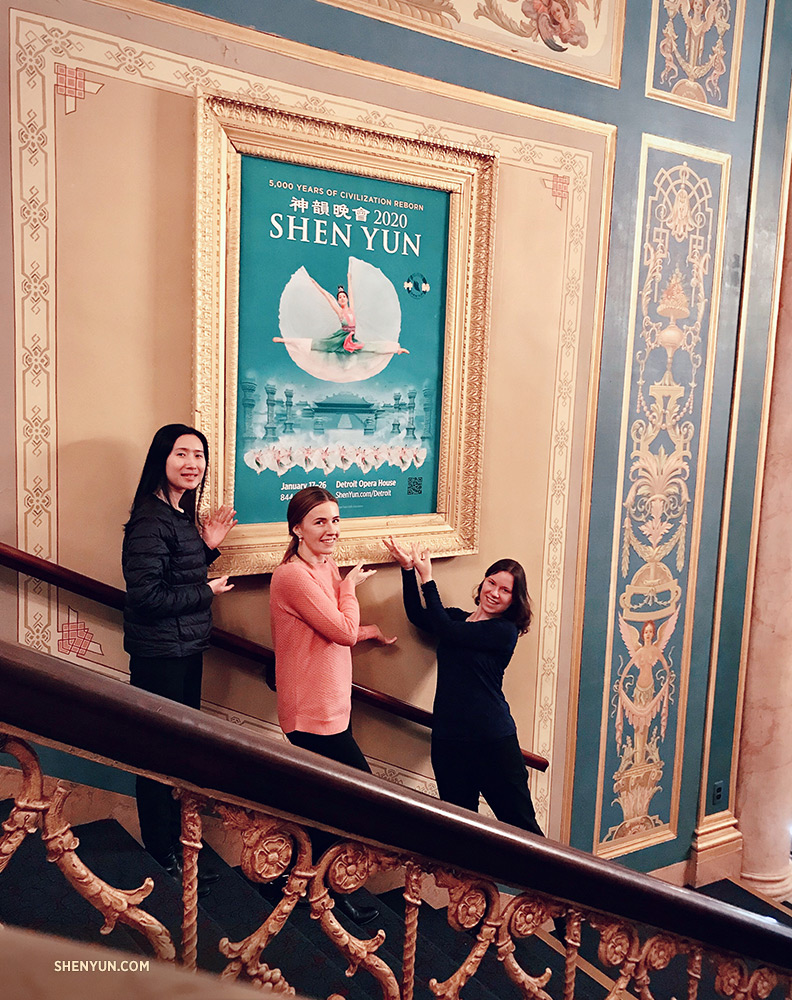
Aqui está uma foto do belo saguão da atemporal Detroit Opera House. A partir da esquerda: violoncelista Jasmine Jordan, violista Paulina Mazurkiewicz e oboísta Leen De Blauwe ao lado do pôster do Shen Yun emoldurado requintadamente.
Você acha que a Opera House pinta suas paredes para combinar com o fundo do pôster do Shen Yun todos os anos?
21 de janeiro: Motor City
Dia de folga em Detroit hoje, antes de cinco dias consecutivos de apresentações. Oito dos nossos rapazes, no espírito de Motor City, saíram para uma corrida de kart.
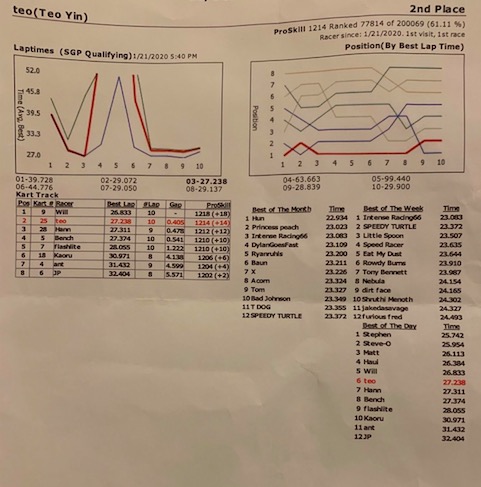
Era um negócio sério, completo com equipamentos de segurança, um briefing formal e planilhas de análise de desempenho.

Então o que acontece quando um grupo de dançarinos com necessidade de velocidade usa sua agilidade, reações rápidas e tempo perfeito para correr? O único músico do grupo vence.

O violinista Will Zhou fica mais alto (embora apenas um pouco) que os dançarinos Teo Yin (segundo) e Jun Liang (terceiro).
22 de janeiro: Perguntas e respostas do desafio de intervalo
Estamos prestes a começar a segunda parte de nosso período de 10 shows em Detroit, com uma apresentação hoje à noite, amanhã à tarde, sexta à noite, duas no sábado e uma no domingo antes de partirmos. Dito isso, não nos apresentamos na segunda ou terça-feira. E nosso show no domingo foi uma matinê antecipada, então serão mais de 72 horas entre os shows.
Alguns dias de folga podem parecer um fim de semana normal, mas em turnê, quando estamos nos apresentando quase todos os dias, dois ou três dias sem shows parecem muito tempo. Viajar para o exterior costuma ser sequências de vários dias sem apresentações, com voos intercontinentais e tudo. Mas na América do Norte pode haver apenas algumas dessas turnês, e pode parecer um pouco estranho.
É claro que os artistas estão acostumados a estar dentro e fora do palco. Então, vou incomodar algumas pessoas durante o jantar e perguntar se o intervalo de dois dias apresenta algum desafio:
Dançarino Jack Han: Parece que não temos um show hoje. E parece uma nova cidade.
Percussionista Brian Marple: Com uma dispensa de dois dias, a memória muscular fica um pouco gorda. A sensação da música não está tão ao seu alcance, então você precisa se concentrar muito mais para obter a mesma precisão.
Dançarina Betty Wang: Tenho que me certificar de que aqueci muito bem, incluindo todos os pequenos músculos. E também praticar todas as técnicas que temos para o show no aquecimento, para termos confiança no palco.
Pianista Hui-Zhen Chen: Existe alguma diferença? Eu terei que te dizer depois de estar no palco.
Dançarina Lily Wang: Lavanderia. Não estando no teatro com acesso às máquinas de lavar, tenho o equivalente a dois dias de lavanderia para dançar.
Flautista Helena Huang: Depende se você praticou ou não. Se você praticou adequadamente, não há problema.
Fagote Steven Louie: Um bom músico está sempre preparado.
Concertino Tseyu Chang: Desafio? Sim, o desafio é que eu realmente sinto que quero mais dois dias de folga.
Dançarino Ben Chen: Não será difícil ter energia, mas precisa focar a mente na coisa certa. Com técnicas difíceis, por exemplo em um dia de dois shows, no momento em que você chega à apresentação noturna, você já fez isso com sucesso à tarde, e você fez isso antes de cada show durante o aquecimento. Então você sente que acabou de fazer isso. É mais sobre como voltar à rotina mental. Ainda assim, são apenas dois dias — não é como se você tivesse deixado seu carro parado ali durante todo o inverno e estivesse tentando ligá-lo novamente.
E aí está. Devemos ser capazes de ligar este carro sem problemas.
23 de janeiro: A trombeta silenciosa

Falta uma hora para o show, e Aleksandr Antonov está parado no corredor do porão do teatro. Seus cotovelos estão levantados, seus olhos estão fixos em algum lugar à frente, nem perto nem longe, e sua trombeta está pressionada contra sua boca. Seus dedos estão se movendo quase tão rapidamente quanto sua mente, mas nenhum som sai.
Aleksandr, conhecido principalmente como Sasha, cresceu em São Petersburgo, na Rússia. Quando ele tinha 6 anos, começou a estudar piano e três anos depois foi testado em um conservatório de elite, onde estudou por oito anos. Mas quando ele completou 12 anos, uma professora recomendou que ele estudasse outro instrumento e pensasse em mudar de curso. Sasha pegou a trombeta.
“No início, senti ressentimento”, diz ele, “mas agora sinto gratidão por minha professora, porque ela contribuiu diretamente para o meu futuro”.
Sendo trompetista, suas habilidades eram muito solicitadas nas orquestras da Rússia, e foi o trompete que o levou ao Shen Yun.
“Isso me mostrou que às vezes, mesmo quando você tem que mudar algo em sua vida, que, no momento, parece um passo para trás ou uma ação indesejada que é forçada, muito mais tarde pode acabar sendo uma coisa boa”.
Sasha concluiu o mestrado com honras em concertos no prestigioso Conservatório de São Petersburgo, na Rússia. Ele ganhou competições internacionais e serviu como trompete principal da Orquestra Sinfônica do Estado de São Petersburgo. Então, ele viu que o Shen Yun tinha uma abertura. Ele decidiu se inscrever.
“Quando cheguei ao Shen Yun, me senti muito confortável, como se este lugar sempre tivesse sido minha casa”, diz ele. “Gostei das pessoas e da forma como era tratado e como todos se tratavam. Descobri que a atmosfera no Shen Yun é de carinho, ajuda, benevolência e compreensão”.
Isso não significa que ele não teve que trabalhar muito. Sasha chegou apenas dois dias antes do início da turnê e tinha apenas dois ensaios antes da noite de estreia. Foi um desafio, mas com a ajuda de sua seção de metais e maestro, ele conseguiu.
Agora que ele está aqui há alguns anos, Sasha elogia as vantagens de fazer parte deste grupo, listando: "Turnês mundiais enormemente grandes sem precedentes", "conhecer pessoas de todo o mundo no Shen Yun" e "elevados critérios morais entre os membros devido a aderir aos princípios morais e conceitos do Falun Dafa”.
Isso faz a diferença para ele no dia a dia. “Isso cria um campo interno e valores de vida bastante semelhantes entre as pessoas aqui, o que traz a sensação de estar em uma família onde todos cuidam uns dos outros e têm consideração uns pelos outros”.
Claro, havia algumas coisas com as quais se acostumar. Mas quando você pergunta a ele sobre elas, não é o que você poderia esperar—muita comida chinesa, sessões de meditação em grupo ou longas viagens de ônibus. Era mais pensar como um grupo do que como um indivíduo, e os altos padrões profissionais, como um código de vestimenta rígido e estar sempre na hora (se você chegar cinco minutos adiantado, estará cinco minutos atrasado). “Para qualquer pessoa vindo ao Shen Yun pela primeira vez, essas podem ser as coisas com as quais se acostumar”.
Sasha fez muitas pesquisas antes de entrar na companhia e sentiu que já sabia um pouco sobre o Shen Yun. “Eu sabia que o Shen Yun é um ótimo lugar, mas assim que vim, no primeiro dia, tive a certeza de que minhas expectativas estavam superadas”.
Ele ficou surpreso com o que chama de “a gestão impressionante de todos os aspectos da produção no Shen Yun”. Acomodações, transporte e alimentação são perfeitamente organizados para os artistas em turnê, enquanto em casa ele desfruta das lindas instalações caseiras.
“Tudo isso oferece as condições mais confortáveis para músicos e dançarinos praticarem e trabalharem na produção”.
Agora, conforme os minutos passam antes do show, ele está de pé em sua blusa azul do Shen Yun, preparando-se para a passagem talvez mais desafiadora para um músico na apresentação deste ano. É um solo de trompete incrivelmente rápido.
Sasha frequentemente pratica não tocando realmente o instrumento, apenas tocando as válvulas com os dedos, imaginando que está tocando, concentrando-se na precisão do dedilhado. Outras vezes, ele toca compasso por compasso em um andamento lento para trabalhar a complexidade dos aspectos desse solo.
“Este é um solo de trompete bastante atípico da perspectiva do repertório clássico mundial, em que o trompete seria mais alto e parecido com fanfarra, às vezes técnico o suficiente, mas não tanto”, diz ele. “Mas este solo é mais, eu diria, como um solo de clarinete ou flauta. Envolve uma melodia saltitante e uma textura muito rápida”.
Existem algumas semelhanças no trabalho sinfônico que envolvem solos de trompete brilhantes que são rápidos, ou aqueles que destacam momentos dramáticos e clímax. Nesses clássicos, diz ele, "o trompete muitas vezes desempenha um papel em entradas ou solos altos, ou como uma função de enriquecimento harmônico das notas longas e 'pedais'”. Mas na música do Shen Yun, o trompete assume papéis adicionais.
“Há muito mais funções e deveres colocados no trompete que definitivamente tornam o trompetista do Shen Yun mais ocupado em comparação com a reprodução de obras sinfônicas clássicas”.
“Os solos são mais complexos, rápidos e saltitantes, e muitas vezes executados de forma aberta e transparente, sem muita cobertura de outros instrumentos, o que requer muito mais precisão e exatidão”.
E é isso que esse solo, que aparece logo antes do intervalo, também exige. E essa passagem, executada por um trompetista russo, corresponde, tanto em exatidão quanto em explosividade, às técnicas correspondentes dos dançarinos chineses no palco.
24 de janeiro: O ano novo chinês
Hoje é a véspera do Ano Novo Chinês, ou chuxi (除夕). O que isso significa é que esta noite, enquanto estivermos no palco em Detroit, os chineses (e os asiáticos em geral) em todo o mundo começarão suas próprias comemorações.
O que também significa é que hoje nossos telefones tocarão fora do gancho. (Ainda dizemos isso? Talvez zumbindo na tela de bloqueio?)
Logo pela manhã, você verá pessoas no saguão do hotel ligando para a família na China ou Taiwan, onde já é noite e as comemorações estão acontecendo. Então, ao longo do dia, todos — chineses, não chineses casados com chineses, pessoas que conhecem chineses — receberão mensagens de texto. Na verdade não são mensagens em si, mais como cumprimentos de longa-metragem completos, completos com cenas de créditos finais.
Eu percebi que eles ficaram mais sofisticados nos últimos anos. Costumava ser um texto simples: Feliz Ano Novo Chinês (guo nian hao). Você pode simplesmente copiar e colar e responder. Feito. E repita 47 vezes ao longo do dia.
Em seguida, evoluiu para todos os tipos de enigmas e rimas inteligentes envolvendo um porco, galo, ornitorrinco ou qualquer que seja o zodíaco do ano.
Este ano é o camundongo ou rato (veja a excelente história de Alison Chen), então podemos esperar um trocadilho chinês equivalente a: "É hora de brincar, o gato está longe!" Ou “Desejo a você um ano novo de ratos!” Ou "Ei, a palavra do rato diz que você vai ter um ótimo ano!" E assim por diante. É um pouco melhor em chinês.
E depois há as imagens. Gifs, vídeos, desenhos animados. Fogos de artifício, balões, confetes. Parece que todo ano é um joguinho implícito para superar o ano anterior. Não tenho tempo para pesquisar a imagem animada holográfica perfeita, original e nunca antes vista do Ano Novo Chinês—é preciso blogar, você sabe. Então eu ainda respondo com o antigo 1.0: “guo nian hao!” esperando conseguir um passe como lao wai (não chinês).
Mas se eu conseguir alguns divertidos este ano, vou compartilhá-los com você em alguns dias. Enquanto isso, coma um nian gao—literalmente bolo de flor de arroz glutinoso, mas também literalmente "um ano elevado!".
Feliz Ano Novo Chinês!
25 de janeiro: Hora da entrevista?
Agendamento. Sou só eu ou está ficando cada vez mais difícil fazer com que duas pessoas se cruzem ao longo do continuum tempo-espaço de alguma forma pré-planejada?
Tenho um amigo em Detroit que trabalha a 10 minutos do teatro. Estamos tentando nos encontrar desde que cheguei aqui e todos os dias algo aparece. E aqui está um exemplo melhor — uma entrevista do Shen Yun que estamos tentando agendar.
Às vezes, durante a turnê, fazemos entrevistas—geralmente programas de entrevistas matinais ou chamadas de rádio. As de rádio são as minhas favoritas: você não precisa se maquiar ou ir a lugar nenhum; você não precisa se vestir. Mais importante, você não precisa falar em sound bites (TV) ou temer que o repórter (jornal) se lembre de suas palavras erradas e o cite como algo bobo. No rádio, você conversa. As pessoas que entrevistam são geralmente bons falantes, curiosos e divertidos de conversar. Suas palavras não serão distorcidas e você geralmente tem pelo menos 5 a 10 minutos para entrar no assunto.
Então, tínhamos uma entrevista de rádio agendada. Ou assim pensei. Alguns e-mails simples e para lá e para cá e pousamos às 14h30 EST, 17h30 PST. E se você começar a ver o problema, você já está um passo à minha frente.
14h30 chega e vou para um camarim silencioso. Eu expulso as pessoas. Eu desligo o radiador barulhento. Eu tenho minha água e estou pronto para ir. Nada. Eu olho para o meu relógio. Hmmm. Uma lâmpada se apaga (desta vez na minha cabeça). Você sabe, acho que eles devem ter entendido ao contrário — 14h30 EST são 11h30 PST. Eles devem ter querido dizer 14:30 PST, 17h30 EST. Ótimo, vou fazer outra coisa agora e volto às 17h30.
17h30 chega. Eu recuperei o mesmo camarim. Coloque uma placa: “ENTREVISTA EM ANDAMENTO. SILÊNCIO POR FAVOR”. Bati na porta da soprano cantora na sala ao lado e educadamente perguntei se ela poderia interromper seu treinamento profissional obrigatório por cerca de 15 minutos, sabe, talvez ir jantar ou algo assim. Preparei um jantar cedo para mim para mais tarde, caso a entrevista se prolongue. Eu tenho minha água. Estou pronto.
17h35. Nada. 17h45. Nada. Pego o telefone e... mando uma mensagem de texto, porque quem ainda liga né? Claramente, não a estação de rádio.
Oh, acontece que eles queriam dizer 17h30 PST, 20h30 EST.
Bem, temos intervalo exatamente às 20h30, então talvez... Não, não, isso não vai funcionar.
Ok, foi reprogramado para terça-feira, quando estivermos em Evansville. Isso definitivamente vai ficar bem. Né?
26 de janeiro: 10 shows realizados
Finalmente terminamos nossa corrida de 10 shows em Detroit. O público aqui estava extremamente entusiasmado. E, como prometido, aqui estão algumas fotos da bela Detroit Opera House, cortesia do violinista Will Zhou (de quem você se lembra também é conhecido por seus talentos de kart, veja 21 de janeiro):
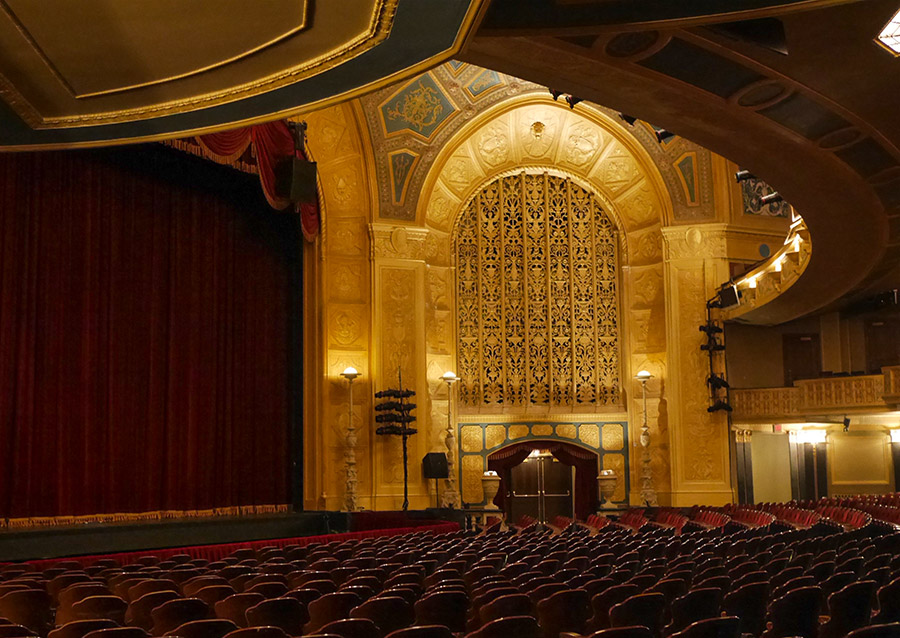

27 de janeiro: Ano novo a distância
O Ano Novo Chinês é uma época para pensar na família. E hoje, em um posto de gasolina no meio de Ohio, um mac-n-cheese também me fez pensar sobre isso.
Crescendo em Israel nos anos 80, eu costumava ansiar por alguns dos alimentos que experimentei enquanto vivia por alguns períodos na América. Minha falecida avó, que era da Califórnia, nos visitava talvez uma vez por ano e sempre vinha com duas malas: uma para suas roupas e uma cheia de comidas americanas que não podíamos comprar em Israel—Lucky Charms, marshmallows, Charleston Chews, cascas de taco e caixas de mac-n-cheese.
Essas caixas de macarrão Kraft custam talvez 25 ou 30 centavos cada, mas eram preciosas para nós, e as guardaríamos para aniversários e outras ocasiões especiais. Então, hoje, enquanto eu estava do lado de fora de um posto de gasolina Pilot comendo um copo de mac-n-cheese quente, meio que não dando valor, minha mente saltou para como nós valorizamos as coisas quando elas são limitadas, e como valorizamos as coisas depois que elas se vão.
O que me traz de volta ao Ano Novo Chinês. A imagem abaixo, postada na página do Facebook do Shen Yun, fez alguém do meu grupo chorar:

É apenas uma pequena imagem fofa de uma família reunida ao redor da mesa para o Ano Novo, três gerações felizes, se simplesmente, curtindo a companhia um do outro. Mas, para essa pessoa, a imagem era um lembrete de momentos não mais possíveis.
Esta é uma realidade para muitos dos meus amigos e colegas. É um tipo de perseguição que não vai virar manchete: ‘Dançarino não pode se juntar à família no ano novo chinês’. ‘Violoncelista não tem permissão para comparecer ao casamento da filha’. Mas chega perto de casa.
Há alguns anos, uma artista estava em turnê comigo quando seu pai faleceu repentinamente na China. Ela tinha estado particularmente perto dele, mais perto do que quase qualquer outra pessoa no mundo. Ela não o via há anos, separada porque, como praticante do Falun Gong e membro do Shen Yun, ela não poderia voltar para a China. Se voltasse, seria apenas presa, interrogada ou pior. Ela também não poderia voltar para o funeral.
A China hoje pode parecer muito aberta e avançada. Mas aqueles que criticam o regime comunista chinês da maneira errada — às vezes apenas por meditar em um parque ou distribuir um panfleto — eles experimentam a ira de uma ditadura da velha guarda.
Talvez essa dupla realidade possa ser comparada alegoricamente à Alemanha Ocidental e à Alemanha Oriental. Para alguns, até aquele momento você experimenta como é realmente o regime, você mora na Alemanha Ocidental, parte do mundo livre. Você navega no que pensa ser a Internet, viaja para o exterior, aproveita a família, faz compras e lida com o dia-a-dia que todos nós lidamos.
Por outro lado, se você mora do outro lado da parede — e você pode nem ter certeza de como você chegou lá, mas você chegou, talvez por se juntar a um grupo de artes cênicas que o governo não gosta — então você tem agentes da Stasi seguindo você, ouvindo suas conversas telefônicas e hackeando seu e-mail, mantendo dossiês em cada atitude sua e ameaçando sua família e amigos para ficarem longe de você. Se você escapou do lado leste para o lado oeste, voltar para as férias não é uma opção.
No Shen Yun, temos uma dançarina cujo pai foi preso, torturado até a morte e seu corpo jogado em uma vala; ela tinha 15 meses. Temos outro dançarino cujo pai foi prisioneiro de consciência por 12 anos. Temos um músico que quase morreu de fome e viu "cabeças esmagadas como melancias" durante a Revolução Cultural de Mao. Existem muitos outros.
Em comparação, eu acho, não poder ver seu pai uma última vez ou se juntar a seus avós idosos nas férias pode não parecer muito. Mas para muitos de nossos artistas da China, nesta época do ano ainda dói.
28 de janeiro: Bem-vindo a Evansville
Acabamos de fazer nossa primeira apresentação aqui em Evansville, Indiana.
Evansville é, entre outras coisas, famosa por onde A League of their Own foi filmada. Ok, então é quando todos que me conhecem começam a revirar os olhos e temer que isso seja um blog de beisebol. Não, este não é o blog onde conto que conheci minha esposa jogando beisebol e que este era o filme favorito dela. Então eu não vou te dizer isso.
Na costa norte do rio Ohio, Evansville faz parte de uma região de três estados que inclui Indiana, Kentucky e Illinois. É como se estivéssemos em nossa casa ao longo do rio Delaware, em Nova York, onde você pode trabalhar em N.Y. durante o dia, abastecer em Nova Jersey e jantar na Pensilvânia.
Uma coisa que você percebe logo de cara (desculpe, prometi que não seria um blog de beisebol) é que, como posso dizer isso sem parecer que estou fazendo generalizações estereotipadas, as pessoas aqui são legais.
Elas são muito legais, na verdade. Percebi isso nos primeiros minutos no saguão do hotel, quando três membros diferentes da equipe do hotel se aproximaram para nos receber com cordialidade. Reparei nisso hoje, dando uma entrevista na estação local da NBC. Enquanto esperávamos pela nossa vez — estávamos encaixados entre alunos do ensino fundamental falando sobre seus projetos de caridade e o xerife da cidade — cada pessoa que foi ao programa veio e apertou a mão de todas as outras pessoas que estavam esperando, tiveram consideração sincera no que eles estavam lá para fazer, e sinceramente desejou-lhes o melhor. Então, o âncora da TV, o ícone local Mike Blake, me deu um aperto de mão caloroso e amigável e conversou comigo o máximo que pôde durante os intervalos comerciais. Ele é uma lenda aqui, tendo estado no ar cinco dias por semana por 40 anos, mas não consigo me lembrar da última vez que um apresentador de TV fez tanto esforço para se certificar de que eu estava perfeitamente à vontade.
E você podia ver isso com o público quando, durante a chamada da cortina, os membros da audiência se levantaram para apertar a mão do maestro e mandar beijos para os artistas.
É uma daquelas coisas que talvez normalmente não percebamos que está faltando, já que passamos a maior parte do nosso tempo em grandes cidades em ritmo acelerado. E então você se dá conta quando você vê — oh, sim, talvez seja assim que as relações humanas deveriam ser.
29 de janeiro: Trabalhando com música clássica
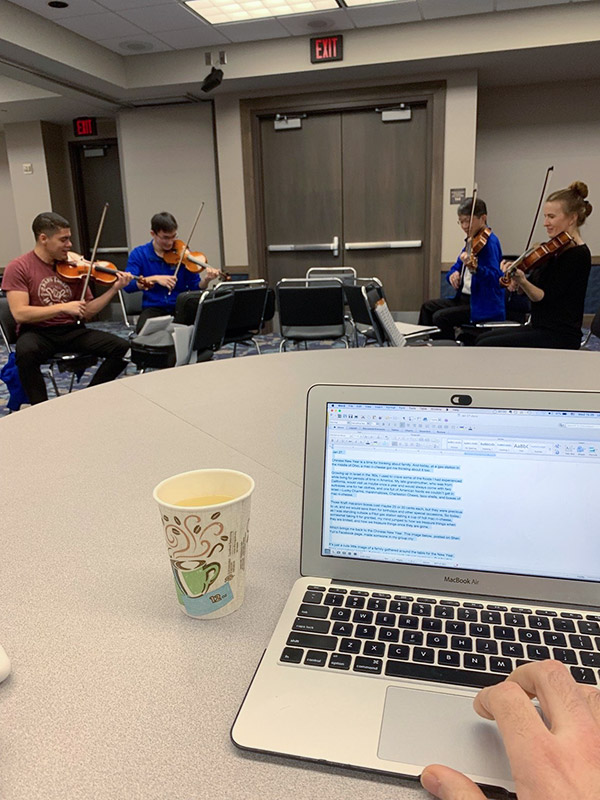
Eu adoro trabalhar com música clássica, você não? Na sala verde dos bastidores do Evansville Old National Events Plaza. A partir da esquerda: Gustavo Briceño, Ian Chung, Chungyi Chen e Paulina Mazurkiewicz. O violoncelista estava faltando em ação, mas ainda soou ótimo!
30 de janeiro: Hotéis mal-assombrados
Acabamos de estacionar em nosso hotel em Milwaukee e tenho o prazer de informar que não é o Pfister Hotel. Nem o Ambassador Hotel. Há um punhado de hotéis em Milwaukee que são notoriamente mal-assombrados e temos membros da companhia que podem testemunhar.
Há alguns anos, uma de nossas companhias foi colocada em um desses hotéis. Uma soprano e um membro da produção que compartilhavam um quarto foram acordados no meio da noite por passos e sombras se movendo pela sala. Luzes acendendo e apagando. Você sabe, o de sempre.
O Pfister Hotel é realmente famoso entre os jogadores de beisebol, já que os times da Major League costumavam ficar lá quando estavam na cidade para jogar contra os Brewers. Este website coletou algumas das alegações dos jogadores sobre atividades paranormais. Aqui está uma de uma ex-estrela do Washington Nationals:
E aqui está uma história de outro website:“Eu coloquei um par de jeans e uma camisa naquela mesa ao pé da cama. Quando acordei de manhã — juro por tudo — as roupas estavam no chão e a mesa estava do outro lado da sala.”
“Durante sua primeira noite no hotel, ele experimentou uma ampla gama de atividades. O homem afirmou que teve problemas com o telefone quando ligou para o serviço de quarto. Havia estática e o telefone continuava sendo desconectado. Ele ouviu uma batida na porta, que presumiu ser o serviço de quarto, mas na verdade não havia ninguém lá.
“Acontece que não havia crianças e apenas três outras pessoas hospedadas naquele andar. As coisas foram ficando cada vez mais estranhas. Sua bolsa de higiene no banheiro estava vazia e os itens espalhados por todo o chão. As roupas que o convidado deixara para o dia seguinte foram jogadas nele na calada da noite. O convidado viu uma figura de sombra no final de sua cama. A figura começou a empurrá-lo para baixo e rir. Quando o convidado finalmente pôde sair, ele recebeu outro quarto onde nada de incomum aconteceu.”
Nosso hotel é bom e novo, sem histórico de assassinatos ou incêndios ou qualquer coisa assim, apenas café fresco no saguão, uma academia limpa e muitas tomadas para carregar dispositivos.
Alguns anos atrás, enquanto nos apresentamos em Long Beach, Califórnia, ficamos no histórico Queen Mary. Este antigo transatlântico britânico tinha sido convertido em um hotel e, embora os quartos fossem pequenos, dormir a bordo de um navio e passear no convés era como desfrutar de um cruzeiro, mas sem enjôo (ou ir a qualquer lugar, eu acho) e foi bem legal.
Ainda assim, havia rumores de que o navio era assombrado, tendo experimentado uma colisão catastrófica com um de seus navios de escolta durante a Segunda Guerra Mundial. Ele foi listado como um dos 10 lugares mais assombrados.
Lembro que nossos dançarinos se divertiram com isso. Alguns pensaram que viram algo. Outros poderiam se importar menos. Mas eles fizeram um vídeo muito engraçado que envolvia lençóis e estranhos encontros nos corredores. Da última vez que estivemos em Long Beach, também estávamos em um hotel diferente e mais novo.
31 de janeiro: Ratos sem fim
Então, lembre-se de como eu falei sobre como a cada ano novo chinês nossos telefones são bombardeados com saudações de todos os tipos (veja a postagem de 24 de janeiro)? Bem, não sei se é porque o zodíaco do camundongo/rato deste ano não é inspirador ou, mais provavelmente, porque as pessoas estão acompanhando de perto as notícias na China e não se sentindo particularmente festivas, mas este tem sido o Ano Novo chinês mais tranquilo dos últimos tempos.
Recebi uma mensagem que incluía um jogo tradicional de palavras. Homônimos de amor chineses — palavras que soam exatamente iguais, mas significam coisas diferentes. Sim, são basicamente trocadilhos. Mas pelo menos eles são ingraçados em chinês.
A palavra chinesa para camundongo ou rato (鼠) é pronunciada shǔ. Também é assim que você diz "contar" (數), bem como a contagem em "incontável" ou "inúmeros".
E então meu amigo usou isso para o seguinte desejo de Ano Novo:
“Desejo a você e sua família:
Felicidade inumerável (ratos sem fim)!
Inúmeros (ratos sem fim) ganhos!
Inúmeras (ratos sem fim) bênçãos !
Saúde inumerável (ratos sem fim)!
Paz inumerável (ratos sem fim)!”
E aqui estão as poucas imagens que recebi:




1º de fevereiro: Não é da China
A trágica e perturbadora notícia do coronavírus é algo que as pessoas em nossa companhia, tenham família na China ou não, estão observando de perto e falando sobre. Enquanto isso, estamos começando a ver o impacto disso aqui, mas não da maneira que você possa imaginar.
Acontece que muitos membros da audiência ainda pensam que o Shen Yun é da China. E por isso ligam para os teatros e bilheterias para saber se as apresentações estão ocorrendo conforme o previsto. Então, emitimos um comunicado à imprensa para resolver isso. Aqui está a parte inicial, com um link para a versão completa abaixo:
Com a preocupação do público com o coronavírus compreensivelmente alta, alguns membros da audiência têm perguntado se a companhia ainda está programada para se apresentar. Os membros do público receberão boas notícias: o Shen Yun não é da China e as apresentações continuarão conforme programado; nenhum show foi cancelado.
O Shen Yun está sediado em Nova York, não na China. Os artistas não vão à China há anos, não têm contato direto recente com pessoas da China e, na verdade, o Shen Yun nem mesmo tem permissão para se apresentar na China.
Comunicado de imprensa completo
2 de fevereiro: Prosa de Steven
O blog de hoje é um pouco de prosa, trazido para nós como cortesia do músico Steven Louie:
O grito de batalha de cada guerreiro ecoa pelos corredores silenciosos.
Cada guerreiro se prepara meticulosamente para uma batalha feroz da qual ele pode não sair com vida.
Eles foram barbeados.
Eles apertam os cintos, prontos para o que está por vir.
Nem todos eles são iguais.
Alguns são mais velhos; alguns são mais jovens. Alguns são mais gordos; alguns são mais magros.
Mas não importa a aparência, eles estão ansiosos para lutar.
Esperando pacientemente na posição pelo momento certo.
Eles estão realmente prontos?
Será que o frio de gelar os ossos os fará tremer?
Será que o calor escaldante os fará suar?
Eles podem lidar com isso?
A verdade é que nenhum deles está absolutamente pronto.
Apenas as provações e tribulações da batalha o dirão.
Com um último rugido de seus gritos de batalha, eles saltam para a batalha.
Com um general brilhante, a vitória será alcançada.
* * *
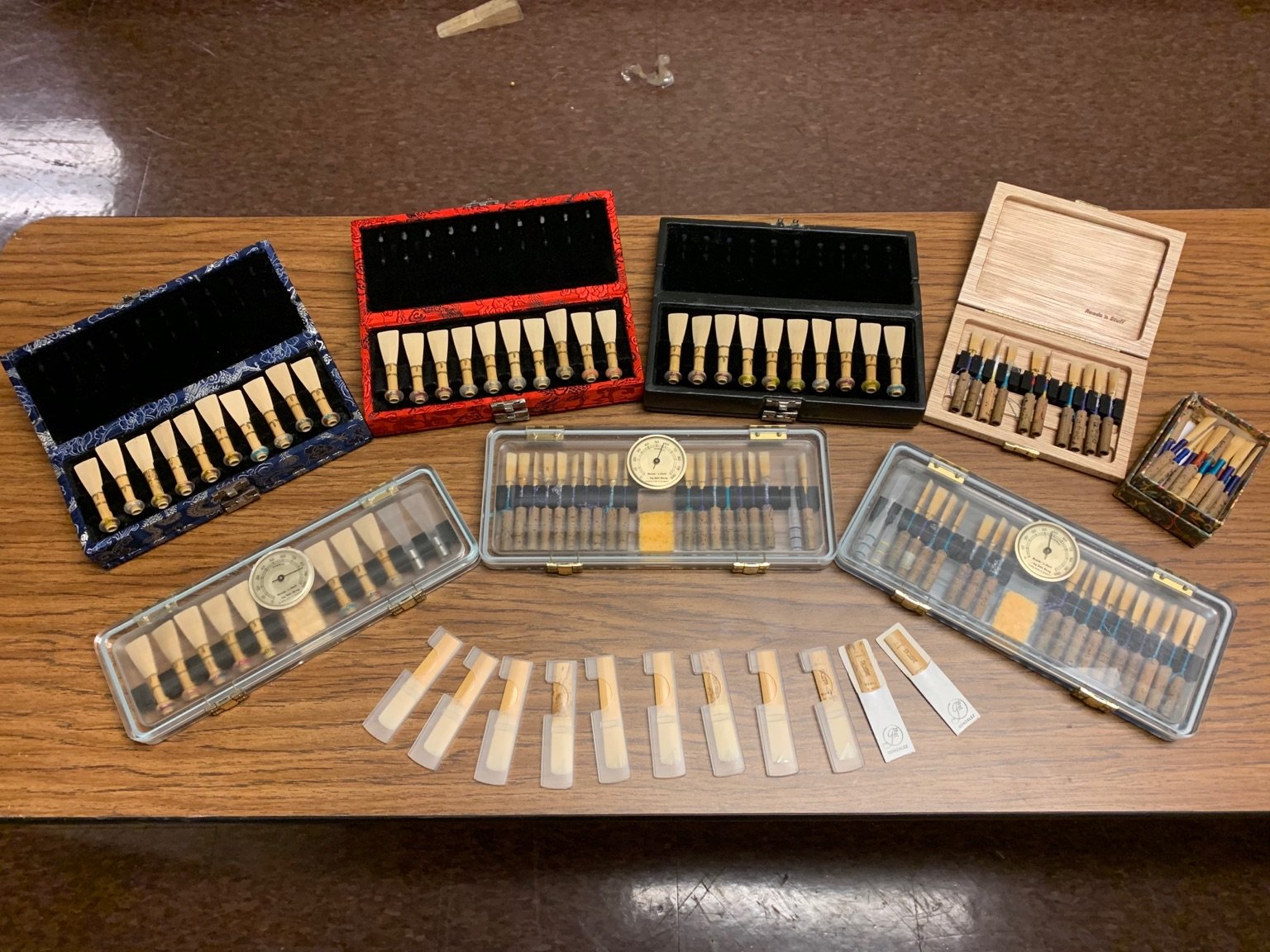
Steven está falando, é claro, sobre suas palhetas de fagote:
Perguntei quantas horas ele passou preparando as palhetas. Ele disse que passou quatro horas por dia, todos os dias, de junho a dezembro, para preparar as palhetas para a turnê deste ano.
Aqui está a mensagem de Steven para outros tocadores de sopro, que podem se encontrar à beira da insanidade enquanto suportam tal trabalho duro.
Para meus tocadores de palheta aliados:
Elas podem ser ruins,
Elas podem ser boas.
Apenas faça seu melhor,
Exatamente como você deveria.
3 de fevereiro: Uma revisão britânica
De vez em quando, alguém me encaminha uma avaliação da performance que eles realmente gostariam de compartilhar. Nosso web designer me enviou esta, e eu achei tão legal que gostaria de compartilhar com você aqui também.
Vem de uma entrevista com a atriz britânica Dannielle Gostling. Você pode assistir a entrevista aqui.
E aqui está uma citação dela, caso você não queira sair da página ainda.
“Achei que foi incrivelmente profundo e incrivelmente importante e a coragem necessária para que as pessoas usem sua habilidade, seu ofício e sua arte para transmitir uma mensagem que é tão importante.”
Mas sério, eu recomendo assistir ao vídeo. É comovente e também muito britânico.
4 de fevereiro: Tosca no Shen Yun
Se você acompanha regularmente este blog, sabe que geralmente divido um camarim com nosso maestro Milen Nachev, que é originário da Bulgária. Outro dia, Milen me contou animadamente sobre uma resenha de uma de nossas performances por uma compatriota e uma das sopranos mais famosas do mundo — Raina Kabaivanska. Ela já cantou com Luciano Pavarotti e contracenou com Plácido Domingo. Alguns a consideram a melhor Tosca de todos os tempos na ópera de Giacomo Puccini.
E, depois de assistir ao Shen Yun na tarde de 19 de janeiro, a Sra. Kabaivanska concordou em ser entrevistada para a câmera por nosso parceiro de mídia NTD. Aqui está o que ela tinha a dizer. Você também pode vê-la e ouvi-la falando essas palavras em um belo italiano aqui:
“Foi mágico! Acabo de emergir de um mundo mágico de cores, harmonia e perfeição. Devo dizer que na minha vida já vi muitas apresentações, muitos balés, mas tanto profissionalismo, realmente, é raro. Eu diria que há um espírito nessa companhia, e esse espírito guia esses artistas maravilhosos. Estou muito feliz por ter estado aqui e por ter feito parte desta magia... Foi uma grande descoberta para mim ver o espírito da China antiga renascer, e expresso minha gratidão aos organizadores.”
5 de fevereiro: Em Madison/Coreia do Sul
Hoje é a nossa segunda de duas apresentações em Madison, Wisconsin. Estávamos discutindo como o Centro de Abertura para as Artes aqui é uma reminiscência de alguns teatros no Japão e na Coréia — deve ser algo sobre como o belo interior de madeira e o estofamento cinza no corredor combinam com as janelas do chão ao telhado no saguão.

No saguão, o dançarino Ben Chen tirou esta foto de alguns de nossos dançarinos durante o treinamento diurno. A partir da esquerda: Shawn Ren, Antony Kuo, Bill Hsiung, Teo Yin (escondido) e Jun Liang.

6 de fevereiro: Obrigado, Kirk!
O que seria uma visita a Wisconsin sem queijo?
Wisconsin é o maior estado produtor de queijo da América e é o lar do mercado de queijo, o Mars Cheese Castle, e cheeseheads, como a maioria dos meatheads sabe.
Por um tempo, nossas visitas a Milwaukee e Madison foram bem monótonas no departamento de queijos, e foram bem baixas no medidor de queijo, a menos que você conte as piadas de MC.
Entra Kirk. Kirk é um dos melhores ajudantes de palco que você conhecerá, e passamos algum tempo juntos preparando na terça de manhã. Então, antes do nosso show ontem, ele me puxou de lado e disse que tinha algo para mim. Saiu... um saco de queijo. Coalhada de queijo, para ser mais específico. Mais especificamente, com um prêmio de aliteração animal: Bucky Badger Combo Cheddar Cheese Curds.


Hoje, enquanto dirigíamos por um pouco de neve de Madison a Indianápolis, eu abri o saco e apreciei os coalhos borrachudos e totalmente divertidos enquanto os compartilhava com todos no ônibus.
Obrigado Kirk! Espero vê-lo em Madison novamente em breve!
7 de fevereiro: Apresentando-se no Egito Antigo
Um longo dia de preparação no Old National Center de Indianápolis, Murat Theatre. É um local único, diferente de qualquer outro que eu já vi antes, com um tema egípcio antigo forte e reconhecidamente assustador.
As docas de carga ficam bem escondidas, pois são pintadas para fazer parte dos murais que decoram todo o edifício.
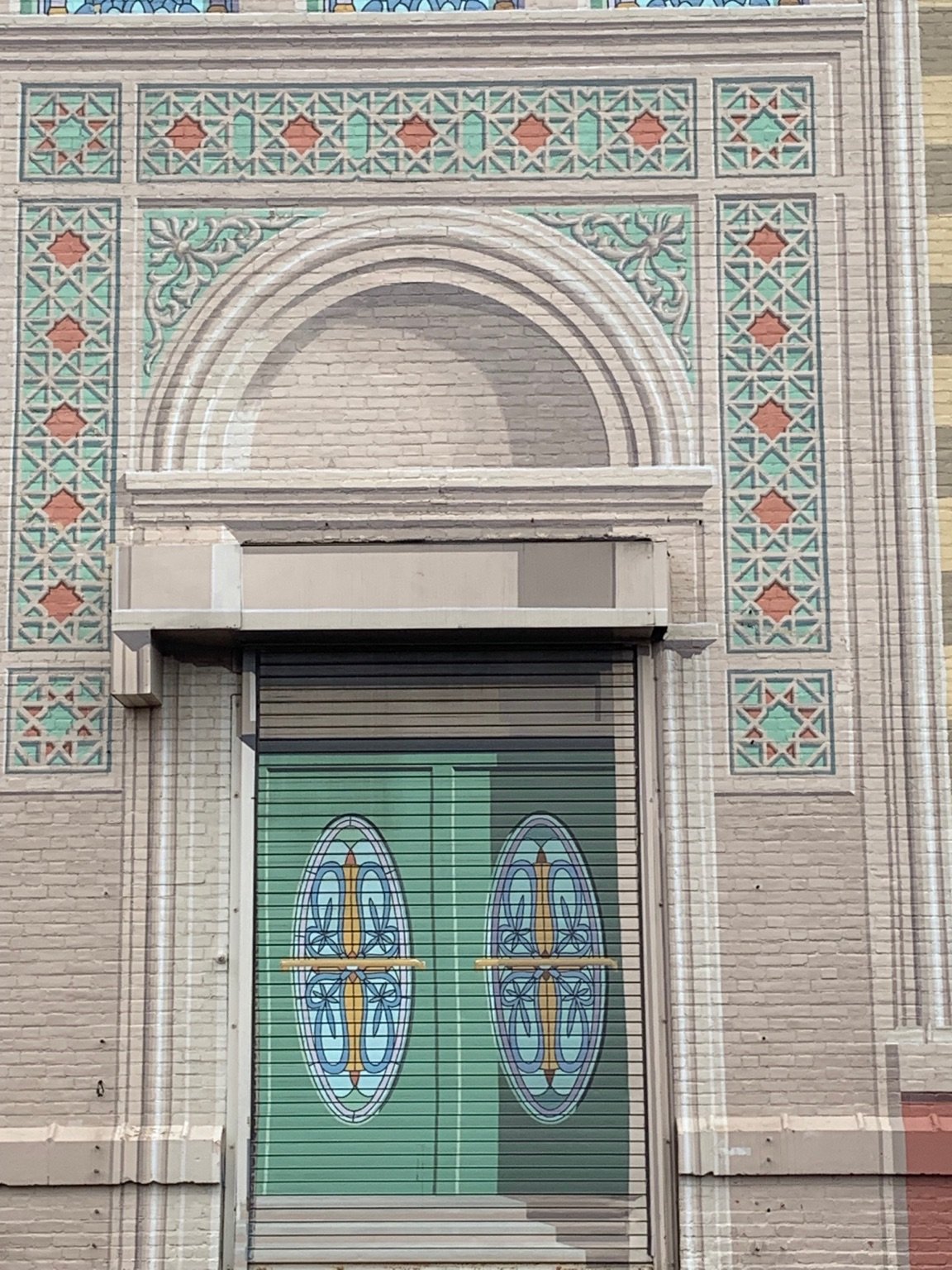
Os portões das docas se abrem na parede de trás do palco, o que esta manhã significa que o palco estava aberto a 28 graus do lado de fora durante boa parte do carregamento. Felizmente, também há um Starbucks nas proximidades.
O Old National Centre colocou uma placa muito bonita de “Bem-vindo Shen Yun 2020” e, pelo que entendi, os tickets para nossas três apresentações no teatro de 2.500 lugares estão quase esgotados. Dois shows amanhã, um no domingo.

8 de fevereiro: Festival das Lanternas
Feliz Festival das Lanternas!
Hoje marca o último dia das celebrações do Ano Novo Chinês. O Festival das Lanternas é o décimo quinto dia do primeiro mês lunar e é chamado de yuan-xiao-jie em chinês. Jie significa feriado e yuan-xiao significa "noite primária", mas também "bolas de arroz glutinosos doces".
Essas bolas também são chamadas de tang-yuan (que significa "rodada de sopa"), mas alguns chineses insistem que há uma grande diferença entre as duas, então tome muito cuidado para não confundir uma com a outra ou você vai ter uma longa palestra sobre as nuances sutis, mas supremas, das técnicas de recheio de bola de arroz glutinoso (se você quiser entrar na toca do coelho, consulte este blog taiwanês em chinês: "Se você erroneamente tomar yuan-xiao por tang-yuan, você está cometendo o erro dos erros!").
O que está claro, porém, é que as bolas redondas simbolizam a integridade da família e o desejo de um ano tranquilo e pacífico pela frente.
E, claro, o apresentador local preparou algumas para desfrutarmos em nossa última noite aqui em Indianápolis. Aqui está o violista James Hwang curtindo uma:

Outras atividades do Festival das Lanternas costumam envolver dar um passeio noturno para apreciar as lanternas coloridas que decoram as casas (um pouco como dar um passeio para ver as luzes de Natal) e, principalmente para as crianças, tentar resolver enigmas pendurados em lanternas.
A verdade é que, em turnês, muitas vezes esquecemos que dia da semana é, muito menos que feriado, e a maioria das pessoas que eu desejei "Feliz Festival das Lanternas!" para responderem com: "Hoje é o Festival das Lanternas?" "Não é amanhã?" Ou "Pensei que fosse no ano passado".
De volta à nossa sede em Nova York, os prédios de madeira no estilo da Dinastia Tang são enfeitados com dezenas de lanternas brilhantes, cada uma com cerca de um metro de altura — rosa, roxo, amarelo, verde. Aqueles de nós que por acaso estiveram em casa por este ano, vão se lembrar do calor lúdico das lanternas em meio às noites frias e claras e às colinas nevadas.
Esses foram os momentos em que você quer apenas parar, olhar para as estrelas e absorver o lindo som da quietude.
Para saber mais informações sobre o Festival das Lanternas, consulte “O conto da humilde lanterna.”
9 de fevereiro: Espacate perfeito
Como os dançarinos se tornam tão flexíveis? Eles simplesmente nasceram assim? Ou treinam desde tenra idade?
Bem, esses dançarinos que você vê segurando os pés bem acima da cabeça, pulando em espacates perfeitos, girando uma perna ao redor do corpo e assim por diante, trabalham muito, muito duro.
Claro, eles começaram bem jovens, mas na verdade a maioria não fez muitos alongamentos antes do início da adolescência. Alguns professores de dança até mesmo desencorajam as crianças mais novas e seus pais de alongar muito, especialmente o alongamento assistido, pois eles dizem que pode afetar o crescimento saudável do corpo — e para alguém com aspirações de dança profissional, boa altura e membros saudáveis são essenciais.
Mas mesmo agora, como dançarinos profissionais que atuam todos os dias com grande flexibilidade, eles não apenas mantêm, mas também se esforçam constantemente para aumentar seu alcance.
Quando fazem um espacate frontal no solo não é mais um desafio, um bloco de ioga é introduzido. Depois, um degrau. Em seguida, um bloco de ioga em um degrau. E assim por diante.
Nesta foto, tirada pela projecionista Regina Dong, as dançarinas (começando com Yoriya Kikukawa, Pamela Du e Cheney Wu) se alongam no saguão do Overture Center for the Arts em Madison:

10 de fevereiro: Sem script
No palco, microfone na mão, gosto de me sentir como se estivesse falando com as pessoas. E, claro, estou, geralmente 2.000 por vez. Mas às vezes, com o holofote em seu rosto e um salão muito silencioso, é preciso se convencer de que existem humanos de verdade lá — pais, mães, tias, tios, avós, filhos, CEOs, artistas, âncoras de TV, ajudantes, e um engenheiro de som. E então, existem aqueles salões íntimos onde você pode ouvir cada murmúrio na audiência. Esses são meus favoritos.
Indianápolis era tal salão. Assim como Baltimore e Fort Worth. Posso ouvir você dizer, “Com licença”, ao encontrar seu assento. Posso ouvir você tossir, espirrar e limpar a garganta. Se você é uma criança fazendo birra, ainda posso ouvi-lo choramingar depois que sua mãe o levou para o saguão para um descanso. Posso ouvir a tampa de sua garrafa de água cair e sua embalagem de pastilhas para tosse destorcer. Se você está sentado na primeira fila, posso ouvi-lo pensar.
E não há nada como ouvir reações sutis do público. É claro que há a adrenalina de uma boa piada — aquele momento de suspense logo antes dela e, em seguida, a tremenda liberação do público. As reações sutis, entretanto, são de alguma forma ainda mais satisfatórias porque, nesses momentos, você foi capaz de capturar a imaginação de alguém.
Duas temporadas atrás, tivemos uma história de dança chamada Devoção (寒 窑). Apresentamos o contexto — uma debutante chegando à idade de casar; em vez de escolher um de seus pretendentes ricos, ela se apaixona por um homem de bom coração e de origem humilde. Seu pai fica indignado e a expulsa da família. Os recém-casados são deixados desamparados e sozinhos, vivendo em uma caverna fria. E então, o jovem casal é separado quando o marido é enviado para a guerra, e a esposa, dizemos ao público, “aguarda ansiosamente seu retorno... por 18 anos”.
Naquele momento, sem falha, eu podia ouvir suspiros no corredor e um ocasional "Oh meu Deus". Eles estavam prontos para assistir a dança.
E aqui em Indianápolis, parecia que estávamos quase tendo um diálogo. Eu: “A dança clássica chinesa tem milhares de anos de história”. Alguém na platéia: “Hmmm”. Poucos minutos depois, eu: “Infelizmente, você não pode ver uma apresentação como esta na China”. Alguém na plateia: “Nossa, nossa”. E outras variações desse tipo de interação, principalmente “um-hmms” e “ahs”, gargalhadas e risadinhas e outras coisas divertidas.
E então... decidimos ensinar o público a dizer, em chinês, “Eu amo o Shen Yun”. Então, explicamos como dizer e então chega o momento da verdade: dizemos: "wo-ai-shen-yun", onde, até este ponto, 1.000 vezes em 1.000 vezes é o que o público responde. E eles fizeram de novo, exceto... um homem esperou um segundo e então interveio: "wo-ai-ni!"
Isso significa "eu te amo".
Isso foi para mim? Não é provável. Para minha parceira, Alice? Talvez, eu acho. Foi para toda a companhia? Ou foi apenas um momento de, 'Ei, eu posso dizer isso, que é semelhante e engraçado’. E foi muito engraçado.
Então, nos segundos de silêncio que se seguiram, tive que fazer algumas contas rápidas: Quantas outras pessoas na platéia sabem o que este homem acabou de dizer? É o suficiente de uma maioria que, permitindo um desvio padrão da média, pelo menos 67% receberia uma resposta a isso ("Obrigado, eu também te amo", ou "wo ye ai ni" ou "wo men ye ai ni” ou “Para quem era isso?” ou “Alice, é para você”)? Vamos ver, 2.500 pessoas, menos 5% chineses, divididos por Indiana…
Decidi seguir com nossa resposta usual, que foi ótima, e deixar a interjeição afetuosa do homem se desvanecer no multiverso etéreo do teatro ao vivo, mas ser eternamente gravada no ciberespaço.
11 de fevereiro: Ouvimos você, parte II
Agora, não queremos que você fique muito constrangido quando vier ver nossa apresentação ou qualquer outra. Como você pode ver no post de ontem, eu realmente gosto de suas reações espontâneas por aí, e os dançarinos também. E essas reações vão desde o riso ao choque, à surpresa, ao enxugamento de lágrimas e aos aplausos explosivos.
Mas adivinha? Se você está sentado na primeira fila, está muito próximo dos artistas. E além dos dançarinos no palco, bem atrás daquela grade na sua frente no fosso, estão as pessoas. Eles são chamados de músicos e, mais ou menos como Transformers, com seus poderes combinados eles formam uma orquestra. Eles estão a apenas alguns metros de distância. E têm bons ouvidos.
Então, primeiro, algumas regras domésticas deveriam ser óbvias, mas assim como o código de vestimenta para o teatro, não são mais sempre óbvias. Nossos membros da orquestra pedem que você não:
• Pendure sua jaqueta no corrimão do fosso.
• Comente em voz alta sobre a música bem no ouvido do maestro.
• Coloque nachos na grade bem ao lado da seção de percussão (por que os teatros servem nachos?)
• Coloque suas garrafas, tampadas ou destampadas, ou copos de vinho na grade do poço.
• Jogue qualquer coisa na orquestra.
Isso deveria ser óbvio, certo?
Tudo bem, agora para a parte principal. Aqui está uma pequena coleção do que os membros da nossa orquestra veem e ouvem do público:
• Os membros da orquestra freqüentemente notam os trajes especialmente bonitos que os membros da audiência na primeira fileira usam: quimonos e maquiagem tradicional completa no Japão, hanbok na Coreia do Sul, meninos com gravata borboleta e meninas com tiaras. Uma senhora com um enorme, quero dizer enorme, afro.
• Um garotinho agitando os braços para imitar os movimentos dos artistas marciais no palco.
• Alguns membros da orquestra viram pessoas na platéia enxugando lágrimas durante a Elegância Eterna deste ano.
• O contrabaixista Juraj Kukan diz que sua parte favorita da apresentação é a cena de abertura, quando a cortina se abre e o público fica maravilhado. Seus rostos mostram isso em uníssono, junto com um suspiro audível. Juraj é muito alto, e ele fica em pé para o seu contrabaixo, então ele tem uma visão clara do público. A maioria dos músicos, porém, não, eles só podem ouvir.
• “Oh, super-homem!” um membro da audiência exclamou durante uma cena mágica este ano.
• Um cão-guia latiu apenas durante os aplausos.
• Em Austin, Texas, depois que o público foi ensinado a dizer "wo ai shen yun", um membro do público acrescentou: "YEE-HAW!"
• Na Flauta Milagrosa deste ano, alguns membros do público disseram: “Oh, sim!” e "Vá buscá-lo!" (Se você viu a dança, você sabe.)
• Em São Paulo, Brasil, quando o tenor Tian Ge começou a cantar e a letra apareceu na tela, um membro da plateia se inclinou para a senhora ao lado dela e começou a ler a letra para ela.
• “Oh, olhe, uma orquestra inteiramente asiática. Espere, não é não.”
• “Olha mamãe! São os violinos, os violinos grandes e os violinos MUITO GRANDES!”
Oh, uma nota final. Se a batuta do maestro, em um momento de êxtase musical, deixar sua mão, voar no ar e pousar em seu colo. Por favor, devolva. Você não pode ficar com ela como uma lembrança.
12 de fevereiro: Momento pessoal solitário
Dia de preparação em Rosemont, Illinois, nos arredores de Chicago. Passei a maior parte do dia no teatro preparando-o para uma exibição de cinco shows. Aqui está nosso gerente de produção, Mark Abbott, durante um momento raro e solitário no palco (foto cortesia do dançarino Ben Chen):

13 de fevereiro: Palco escuro

“Palco escuro até às 18h de amanhã.”
“Palco escuro até às 12h30.”
“Palco escuro 5h às 6h.”
O gerente de palco nos envia essas mensagens quase diariamente. O que é um palco escuro?Eu me coloco em um enorme perigo pessoal ao tirar a foto ilícita acima do palco escuro aqui no Rosemont Theatre. Eu não serei descoberto, entretanto, porque ninguém lê este blog de qualquer maneira.
Há uma razão para um palco escuro. O palco pode ser um lugar perigoso em uma espécie de quebra de perna. Você pode tropeçar em algo ou cair no poço e pousar nos tímpanos. E se você fizer isso, você não quer que aconteça quando o palco estiver escuro e ninguém estiver por perto para se divertir.
14 de fevereiro: Durões de Philly
Espero que todos estejam aquecidos. No início da manhã aqui estava -19º C e parece que muitos de vocês na América do Norte tiveram que lidar com o mesmo. Não estava ventando muito (em Rosemont, ainda estamos a 29 km de Chicago), e a beleza de passar a maior parte do dia no teatro é que você não nota muito o tempo lá fora.
Agradecemos, entretanto, o esforço que vocês membros da audiência fazem para enfrentar o frio, a neve e o trânsito da hora do rush para vir nos ver.
Vimos isso com o público aqui em Rosemont, e vimos na semana passada em Indianápolis, quando casais se abraçavam, se arrastando por um estacionamento gelado enquanto flocos de neve do tamanho de flocos de milho caíam.
E isso me lembra de uma multidão em particular na Filadélfia.
Era uma tarde de dia de semana em 2018 e estávamos nos apresentando no Merriam Theatre. Lá fora estava frio—muito frio. Gelo de janeiro na Filadélfia no chão. Lá dentro, estávamos nos aquecendo para a apresentação. Eu estava me vestindo. Músicos podiam ser ouvidos de cima a baixo nos corredores e escadarias do minúsculo backstage. Os dançarinos se alongavam, pulavam e suavam um pouco. E então o alarme de incêndio disparou.
"O que é isso, isso é um alarme de incêndio?", perguntei ao maestro sobre uma mistura de trompa francesa e trombone. Isso não foi tão surpreendente quanto o alarme de incêndio das cinco da manhã em nosso hotel arranha-céu antes de um dia de dois shows em Gold Coast, Austrália, mas isso é outra história. Então, saímos.
Lá fora, no pequeno beco que leva à porta do palco, alguns dançarinos e músicos já se reuniram. Talvez porque presumimos que isso levaria apenas alguns minutos, ou talvez porque fomos tão bem treinados na escola para simplesmente ir, ninguém realmente se vestiu adequadamente. Os dançarinos estavam em camadas finas e tocadores de cordas sopravam em suas mãos. A companhia inteira estava lá fora maquiada, congelando. Por quase uma hora.
Mas ao virar da esquina, outra linha estava se formando—os membros da nossa audiência. Em uma matinê durante a semana, a maioria era formada por aposentados, e podíamos ver uma linha de cabeças brancas que se estendia da entrada do teatro, passando por nosso beco e até o próximo quarteirão ao longo da Broad St.
Eu os encarei por um tempo. Ninguém se mexeu e ninguém saiu. Eles apenas ficaram lá em um clima abaixo de zero. Eles eram apenas os durões de Philly, criados como Rocky Balboa, bebendo ovos crus antes do amanhecer e socando carne em freezers antes de fazer flexões com um braço?
Já tínhamos passado da hora do show quando o alarme—que descobri que nem foi disparado no teatro, mas em um prédio conectado—finalmente parou e fomos autorizados a entrar.
Toda a companhia teve um coletivo: “Agora, onde estávamos?” momento. Não tínhamos experiência em nos preparar para um show que deveria ter começado há vinte minutos (a menos que você conte aqueles sonhos que todo mundo tem onde o show já começou e você não consegue encontrar seus sapatos, ou seu instrumento, ou seu traje ou o teatro).
Calculamos que tínhamos cerca de 15 minutos, já que o público também tinha que entrar. Então, os dançarinos se aqueceram rapidamente. Os músicos colocam a gravata borboleta e continuam soprando nas mãos. Cerca de 10 minutos depois, peguei um microfone:
“Senhoras e senhores, a apresentação começará em alguns instantes. Muito obrigado por permanecer conosco”. E eu quis dizer isso.
Todas aquelas cabeças brancas congelando lá fora conseguiram entrar. Nenhum assento estava vazio.
Nós ficamos ambos muito impressionados e muito gratos por ter um público como aquele.
15 de fevereiro: 'Back Leg Hold'
Entre dois shows no Rosemont Theatre, a dançarina Liz Lu (que você tem que concordar que é um nome legal) concordou em fazer seu alongamento no meio do palco para que o dançarino Ben Chen pudesse tirar essa foto. Essa técnica é chamada de "back leg hold" ou ban-zi-jin-guan (搬 紫金 冠) em chinês.

16 de fevereiro: Seu Rosemont
Ontem à noite, meu colega de quarto e eu definimos nossos alarmes para a mesma hora exata e esta manhã ambos dispararam na mesma fração de segundo. Poucos minutos depois, saindo lentamente da cama, olhei para ele e perguntei:
“Como dançarino, você acorda dolorido depois de um dia de dois shows?”
“Sim”, disse ele.
“É ridículo que, como MC, eu também?”
Temos mais uma apresentação aqui em Rosemont antes de começar nossa parte mais fria da turnê com Minnesota e, eventualmente, voltar para o Canadá. É um show às 13h (geralmente é 2h ou até 3h, ou devo dizer 15h, na Europa). Então, tudo é empurrado para mais cedo. O almoço agora é cafémoço, por exemplo. Também significa que estaremos de volta mais cedo depois de "atacar" o palco e fazer as malas, e ter uma noite tranquila para desfrutar do nosso bom hotel.
Espero que todos estejam tendo um ótimo fim de semana. E, se você está nos visitando em Rosemont—certifique-se de verificar seu ingresso para saber o horário de início. Vejo você lá!
17 de fevereiro: A vez do Teo
O dançarino Teo Yin gosta de fazer este exercício de peso corporal antes dos shows. Basicamente, é uma parada de mão de um braço contra a parede, e ele diz que funciona com a força e estabilidade do núcleo.

Ele parece gostar de fazer isso precariamente perto do fosso da orquestra. Claro, a parede do proscênio é praticamente o único lugar para fazer isso perto do palco. Mas suponho que ele também goste de olhar de cabeça para baixo no abismo orquestral, um aspecto ousado de sua personalidade que você reconheceria instantaneamente se já o tivesse visto em um layout aéreo completo.
E como um jovem de Taiwan acabou com o nome de Teo? Bem, seu nome chinês é Jingyuan, e até o ano passado seu nome em inglês era Leo. No entanto, na última turnê, tivemos dois dançarinos chamados Leo—este Leo e outro Leo da Coreia do Sul. Os dançarinos adicionaram a cada um uma inicial representando seu país de origem: K-Leo e T-Leo. T-Leo decidiu apenas misturá-lo com Teo. Pelo que eu posso dizer, K-Leo ainda não se tornou Keo.
18 de fevereiro: Escalada
Depois de uma série de shows bem-sucedidos em Rosemont, Illinois, agora temos dois dias de folga abrangendo um dia de viagem para Minnesota. Na segunda-feira, alguns dos dançarinos dirigiram-se a um ginásio de escalada nas proximidades. Acontece que os dançarinos têm uma vantagem distinta neste esporte: eles não são apenas leves e ágeis, mas sua habilidade de fazer espacates em todas as direções os ajuda a ficar perto da parede e alcançar pegadas distantes com seus pés. Mesmo os iniciantes se divertiram.
Aqui está a dançarina Betty Wang com um espacate frontal no topo da parede:

19 de fevereiro: Regras de uma parada para descanso
Qual é a parada perfeita para descanso na estrada?
Aqui estão os parâmetros: Você tem um ônibus (ou dois) com dezenas de pessoas famintas. Eles estão cansados. Eles estão exaustos. Eles estão cansados de estarem exaustos. Eles querem se esticar. Eles querem comer. Acima de tudo, eles PRECISAM fazer xixi.
Você também tem homens e mulheres, chineses e não chineses, adolescentes e músicos com seus 60 anos.
Entendeu? Ok, agora vá encontrar um lugar perfeito para todos pararem. Eu mencionei que você está no Expresso Interestadual no Meio do Nada?
Vamos começar com o que não é uma boa parada para descanso para nossa situação de dia de viagem mencionada acima. Aqui estão três regras de onde não parar:
Regra nº 1: Evite áreas de descanso. Essas são áreas de descanso sancionadas pela rodovia oficial, marcadas por sinais azuis. Elas só são boas se o que você deseja realizar é tirar todos do ônibus, ir para o banheiro e voltar para o ônibus em dez minutos ou menos. Caso contrário, eles têm muito pouco propósito para nós, especialmente porque não temos cães para passear. Eles têm, na melhor das hipóteses, uma máquina de venda automática. Você quer café? Talvez haja uma máquina de venda automática para isso também, com copos de plástico. Quando foi a última vez que você tomou um bom café em um copo de plástico?
Regra nº 2: Evite pequenos postos de gasolina. Este é o irmão gêmeo do mal da área de descanso. Não que a área de descanso não seja má. Ambos são maus. E gêmeos. E também irmãos. Apenas de maneiras diferentes. Aqui você pode conseguir muitos lanches, desde barras de chocolate até Snickers e todas as Milky Ways intermediárias. Mas há uma, ou talvez duas cabines de banheiro. E elas não ficarão limpas quando você estiver no Expresso Interestadual no Meio do Nada. Você gosta de dançar em longas filas? Este é o lugar para você. Caso contrário, continue.
Regra nº 3: Evite sair para ver o que vai encontrar. Você vê uma placa de saída e ela promete um mosaico de locais de fast-food. “Vamos descer aqui”, você pode pensar, “vamos encontrar algo”. Oh, você é tão ingênuo. O que você vai descobrir é o seu ônibus preso no final de um estacionamento, com a única saída envolvendo um espaço livre de 5 pés no caminho para a janela do McDonald's. “Oi, posso anotar seu pedido?” “Sim, só um segundo. O que vocês 35 querem?”
Depois de mais de uma década de experiência nas rodovias dos EUA*, temos alguns conselhos sobre alguns bons lugares para parar.
* Canadá e Europa são um pouco diferentes: no Canadá, as paradas de descanso são na verdade pequenos shoppings com as mesmas redes: Burger King, Tim Horton's, Sbarro. Se você já os viu uma vez, já viu um shopping. Estes têm banheiros limpos e agradáveis e muitas opções de comida. Mas em três tentativas até agora, não consegui obter nada de Tim Horton dentro dos 40 minutos atribuídos do nosso intervalo habitual.
Na Europa, é uma mistura de coisas. Para ser totalmente honesto, acho que a maioria dos meus colegas membros da companhia concordaria relutantemente que, em comparação com as opções americanas, as áreas de descanso europeias são, e digo isso respeitosamente, péssimas. Eles têm um café melhor; eu vou dar isso a eles. Mas 15 euros por um sanduíche frio? E você tem que pagar para usar os banheiros? E as placas nem estão em inglês?
Na ordem inversa, aqui estão nossas recomendações:
Lugar favorito nº 3: Love’s. Esta é uma grande rede de postos de gasolina que atende especialmente a motoristas de caminhão e viajantes de longa distância. Muitas vezes, tem cabines de banheiro suficientes, uma grande variedade de lanches e bebidas, uma seleção de comida quente como pizza, tornados de queijo, cachorro-quente e outros alimentos nutritivos, como Coca-Cola. Às vezes, eles também têm uma rede de fast food anexada, geralmente um McDonald's. Não pode dar errado com o Love's.
Lugar favorito nº 2: TA. Travel Centers of America. Não falta muita coisa no TA além do C. Além de tudo que você encontra no Love's, você também tem Pizza Hut e Taco Bell, talvez até uma lanchonete pequena, bem como todos os tipos de souvenirs de cristal de que você não poderia precisar ou não quebrar em suas viagens. Os TAs são geralmente muito espaçosos, com muito espaço de estacionamento. Definitivamente, uma escolha segura. Se você estiver viajando para o norte de Los Angeles a San Francisco na I-5, há um grande à direita logo depois de você sobreviver ao descer The Grapevine.
Lugar favorito nº 1: Postos de gasolina Pilot. Estes se fundiram com o Flying J alguns anos atrás. Como o Love’s, você não os vê realmente nas cidades, mas os vê muito se passar algum tempo na I-10, I-40, I-80, I-90 e assim por diante. Eles têm todas as coisas essenciais que você encontra no Love’s e TA, mas têm uma seleção mais ampla de cafés. A partir do ano passado, eles até começaram a introduzir máquinas de café expresso automáticas que moem os grãos na hora. A equipe é sempre amigável, e acho que podemos até ter encontrado o kombucha algumas vezes. Os postos Pilot costumam ter um Subway anexado, o que aparentemente é uma opção mais saudável no que diz respeito a fast food. Se acontecer de você ter em seu grupo um tomador de decisões, e estou apenas hipoteticamente falando, é claro, que sente que um Pilot-plus-Subway é a melhor opção, você pode se encontrar lá em cada viagem.
Opção de parada para descanso Bônus: Walmart ou Target. Hoje, porém, não paramos no Pilot, mas no Walmart. Um Walmart ou Target (ouso dizer Kmart? Provavelmente não) como uma parada para descanso não é uma escolha ruim. E não estou dizendo isso apenas porque a ideia de parar aí hoje foi minha. É uma ótima oportunidade para fazer algumas tarefas enquanto almoçamos. Há banheiros em abundância, estacionamento em abundância e muitas opções de comida, incluindo lanches saudáveis como ovos cozidos, frutas e vegetais pré-cortados, barras de proteína e chips cetônicos. Você também pode suplementar tudo o que acabou—pasta de dente, desodorante, xampu e outros itens que mantêm todos cheirosos. Essas superlojas geralmente estão convenientemente localizadas ao lado da rodovia para facilitar o acesso e são grandes o suficiente para que você até mesmo faça alguns exercícios de alongamento de pernas ao longo do caminho. E adivinhe—este Walmart tinha até um Subway.
20 de fevereiro: Condensação
Condensação: O processo pelo qual o vapor d'água se torna líquido, geralmente quando o ar esfria até seu ponto de orvalho. Em outras palavras, o fenômeno da lata de refrigerante suada.
Hoje, em St. Paul, Minnesota, nossa configuração foi super condensada.
Tudo começou nos últimos dois dias, quando as temperaturas aqui oscilavam em torno de -17 ºC e caíam para -21 ºC. Durante esse tempo, todo o nosso equipamento estava no caminhão estacionado do lado de fora.
Então, esta manhã, descarregamos o caminhão. Fomos até a doca de carga e abrimos o portão do elevador. Quando as caixas começaram a sair, as mãos do palco do teatro quase tiveram medo de tocá-las. Você sabe que está frio quando os habitantes locais que viveram em Minnesota por décadas estão sofrendo.
“Cara, esse tubo está frio”, disse um deles.
“Melhor não colocar a língua nisso”, respondi.E então, eu acrescentei: “Você realmente sente nas suas extremidades, no seu nariz, dedos das mãos e pés”.
“Você tem dedos dos pés?”, ele respondeu.
Quando começamos a desempacotar nosso equipamento dentro do teatro, foi aí que a condensação começou. Tudo estava revestido com uma camada branca de algo que já tinha sido H20. Quando o equipamento encontrou o ar quente do teatro, que era mantido com umidade constante de 35%, começou a suar. Nós limpamos o que podíamos e usamos ventiladores para secar alguns de nossos equipamentos eletrônicos.
O percussionista Brian Marple tirou esta foto da placa de Plexiglas usada para separar a seção de percussão da harpa:
Na hora do show, às 19h30, tudo estava bom e pronto como de costume e assim começou nossa série de seis shows em quatro dias.
21 de fevereiro: O duplo duplo
Hoje é o primeiro dia do nosso duplo-duplo em St. Paul. Já escrevemos sobre o duplo-duplo antes—em 2013. E em 2015. E em 2018. Duas vezes.
Um duplo-duplo é um dia de dois shows e outro dia de dois shows consecutivos.
Este é, pelo que eu posso dizer, o único duplo-duplo que nosso grupo planejou para este ano. Alguns anos atrás, eles eram bastante comuns. Em nossa turnê de 2018, tivemos 11 duplo-duplos, incluindo sete finais de semana consecutivos, principalmente no sul da Califórnia. Por mais difícil que fosse a rotina, devo admitir que começamos a melhorar em lidar com eles depois de um tempo, já que até mesmo alguns dançarinos admitiram que se acostumaram com eles. Mas eles são definitivamente exaustivos para todos os envolvidos.
Suponho que seja uma questão de perspectiva. Se um dia começarmos a ter triplo-triplo-triplos, então o duplo-duplo parecerá uma brisa.
Este é um pouco incomum, pois cai de sexta e sábado. Antes, quase sempre eram sábado e domingo, o que significava que provavelmente você tinha a segunda-feira de folga para se recuperar. Desta vez, porém, imediatamente após o duplo-duplo teremos uma matinê no domingo. Então, junto com a noite de estreia na quinta-feira à noite, temos seis apresentações em quatro dias. O recorde é sete, que várias companhias fizeram, geralmente no formato de: 2, 1, 2, 2.
Nosso maestro, Milen Nachev, diria que temos seis shows consecutivos. Ele tem uma maneira única de rastrear os shows. Ele calcula que há dois horários por dia em que pode haver uma apresentação—à tarde e à noite. Então, se você tem um show na segunda à noite e outro na terça à noite, você tem shows dois dias seguidos, mas não tem dois shows seguidos. Me acompanhe? O que você tem é show, sem show, show. Portanto, em nosso caso, temos quinta à noite, sexta à tarde, sexta à noite, sábado à tarde, sábado à noite, domingo à tarde—seis shows consecutivos.
Gosto de pensar em cada noite como um reset. Você vai dormir e é um novo dia. Então, depois dos dois primeiros shows de um duplo-duplo, você vai dormir, acorda, e no dia seguinte não há mais duplo-duplo; há apenas o dobro.
O dançarino Ben Chen diz que seu reset é um cochilo. Se ele cochilar entre dois shows, então é apenas um dia de show.
Tudo isso para dizer sim, todo mundo é profissional e está acostumado a se apresentar tanto assim. Bem mais de 100 apresentações em cada turnê, na verdade, e os dançarinos dançam com vontade a cada show. O mesmo vale para os músicos e todos os outros envolvidos.
Ainda assim, a programação não espera por ninguém. Um duplo-duplo pode encontrá-lo quando você tiver febre. Ou uma articulação realmente dolorida. Ou estar passando por algo pessoalmente. Não importa. Não temos suplentes. Às 19h30, a cortina sobe. É como mágica—de alguma forma, quando isso acontece, todos estão em seus lugares, sorrindo. E lá estão eles de novo, um pouco mais suados, quando a cortina finalmente desce.
22 de fevereiro: 'Te peguei, baby'
A interseção do inverno em Minnesota, um e-mail da Uniqlo com sua coleção de primavera e o segundo dia de um duplo-duplo me fez pensar no... Feitiço do Tempo.
Você já viu o filme. Um meteorologista interpretado por Bill Murray vai a Punxsutawney, na Pensilvânia, para relatar sobre os eventos do Dia da Marmota, e se Punxsutawney Phil vê sua sombra ou não. Ele (Bill, não Phil) fica sem entusiasmo e vai dormir no final do dia. Quando ele acorda às 6h da manhã seguinte, é no mesmo dia novamente, com o rádio tocando novamente: “Te peguei, baby”. Ele é pego em um loop temporal e nada, nem mesmo dirigindo de um penhasco com Phil, pode tirá-lo. Até, isto é, ele acerta o dia.
Aqui em St. Paul, a programação de hoje é exatamente a mesma de ontem. Acordar na mesma hora. Pegar o ônibus ao mesmo tempo. Chegar na mesma hora ao teatro e seguir a mesma rotina. Almoçar às 11h50. Maquiagem às 13h00. Cortina abaixada às 13h30. Reunir-se às 13h45. Primeiro show às 14h00. Intermissão às 15h00. Jantar às 17h20. Segundo show às 19h30. Dizer oi para a mesma recepcionista do hotel. Ouvir a mesma saudação do segurança na porta do palco. Colocar a mesma bolsa no mesmo canto do camarim, e dar um high five para o mesmo membro da orquestra andando na mesma esquina do mesmo corredor no mesmo momento exato.
Então subir no palco com a mesma fantasia e fazer as mesmas danças, tocar as mesmas notas, dizer as mesmas coisas.
É um Feitiço do Tempo redundante, cujo efeito é duplicado por causa das redundâncias inerentemente construídas na programação redundante intrínseca e integral de um duplo-duplo que se repete de forma redundante. É um déjà vu de novo.
Exceto que não é o mesmo. Cada show é um pouco diferente. O público é diferente. A maneira como eles riem é diferente. Hoje tivemos uma senhora com uma adorável risada aguda que cortou o resto das risadas do público todas as vezes.
Às vezes, durante a introdução da orquestra, o público mal pode esperar para aplaudir cada instrumento. Harpa (aplausos). Woodblocks (aplausos). Violino (aplausos). Às vezes, eles se sentam lá muito quietos, inclinando-se literalmente para a frente na borda de seus assentos, olhando para o fosso da orquestra, esperando pelo momento de aplaudir toda a orquestra no final.
"Você se recuperou de ontem?", erguntei a um dos dançarinos principais quando ele passou por mim no corredor, cerca de uma hora antes da matinê.
“Sim, estou bem”, diz ele. “Além disso, não importa. As pessoas estão esperando”.Como ontem. Duas vezes.
Para nós—este é o Feitiço do Tempo, exatamente no mesmo dia novamente. Para a maior parte do público—eles estão, pela primeira vez, vendo o Shen Yun. E para eles, vamos acertar o dia.
23 de fevereiro: O Grande Dia
Ontem foi o Grande Dia. Mais especificamente, ontem marcou o 40º aniversário do “grande dia da história do esporte nos EUA”, de acordo com www.VisitStPaul.com.
2 de fevereiro de 1980. Lake Placid, NY. As Olimpíadas de Inverno. A equipe de hóquei dos Estados Unidos enfrenta as semifinais contra a União Soviética. A equipe dos EUA consiste principalmente de jovens jogadores amadores e inexperientes; a equipe soviética é formada por profissionais grisalhos com vasta experiência em competições internacionais e uma coleção de medalhas de ouro. Apesar de os EUA jogarem em casa, poucos esperavam que eles derrotassem os poderosos soviéticos.
De fato, no meio do terceiro e último período, a União Soviética, com seus uniformes vermelhos e CCCP no peito, liderou por 3 a 2. Mas então o time dos EUA empatou em um jogo de força e encontrou a rede mais uma vez faltando 10 minutos para o fim.
Os 8.500 presentes prenderam a respiração—se é que alguém pode fazer isso enquanto torcem—enquanto os EUA se agarram à liderança de 4 a 3. Vez após vez, os soviéticos atacaram a rede e dispararam. A dez segundos do fim, a multidão iniciou uma contagem regressiva e, a cinco segundos do fim, as últimas palavras do locutor Al Michaels durante o jogo foram: “Você acredita em milagres? Sim!”
Esse jogo ficou conhecido como “Milagre no Gelo”. Dois dias depois, os EUA venceram a Finlândia na final pela medalha de ouro no hóquei olímpico.
Como você pode imaginar, o hóquei é algo grande em Minnesota, e o treinador principal da equipe olímpica dos Estados Unidos de 1980, Herb Brooks, era de St. Paul. Ele construiu sua carreira localmente, primeiro jogando e depois se tornando o treinador principal do time de hóquei Golden Gophers da Universidade de Minnesota a apenas alguns quilômetros de distância, antes de se tornar o treinador da equipe olímpica.
Do lado de fora do Ordway Center for the Performing Arts, onde estávamos nos apresentando, está uma estátua de bronze de Herb Brooks, com os braços erguidos para o céu, capturando sua reação ao término do relógio com uma vitória de 4 a 3.
Agora, 40 anos depois que Brooks voltou ao vestiário e chorou, após uma vitória improvável que significou muito para uma nação seguido de duas décadas da Guerra Fria, a cidade de St. Paul celebrou com o Desfile do Grande Dia.
* * *Estávamos nos preparando para o primeiro dos dois shows, mas podíamos ver pela janela do refeitório pais e seus filhos em camisetas de hóquei reunidos na rua abaixo. Às 13h, de dentro do teatro, a engenheira de iluminação Peiyi Marple capturou esta foto rápida do início do encontro em torno da estátua de Herb Brooks.

24 de fevereiro: Praia de Iowa
Portanto, temos uma situação aqui. O percussionista Brian Marple está no gelo com a engenheira de iluminação e esposa, PeiYi Marple. Veja as evidências:

No caminho de St. Paul, Minnesota, para Omaha, Nebraska paramos para almoçar e, depois de dias e dias apenas de hotel-teatro-hotel-teatro, queria um pouco de passeio. O que você pode fazer no meio do inverno, no meio, embora ligeiramente a oeste, do meio-oeste? Caminhar em um lago congelado. Este é o Clear Lake, Iowa:

Foto do dançarino Jack Han.
Tão óbvio como ele ganhou esse nome, né? Né?
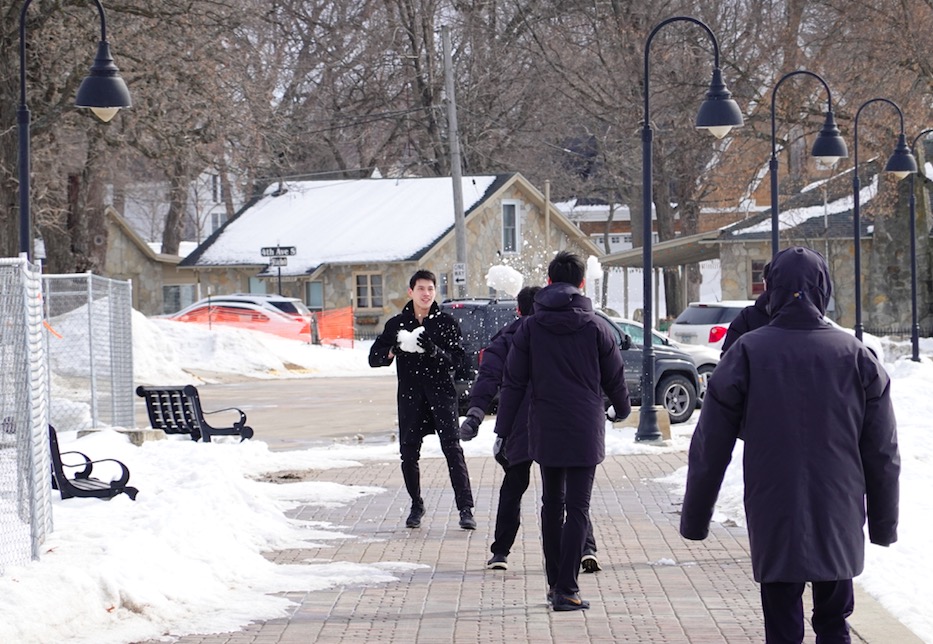
A primeira coisa que saiu do ônibus foi uma luta épica de bolas de neve:

Isso me lembra do filme inspirador Superação: O Milagre da Fé, se você já o viu. Baseado em uma história verdadeira, aparentemente.
E um boneco de neve, feito para se parecer com o fagote Steven Louie. Você pode dizer quem é quem?

E então, tomem isso, todas as outras companhias do Shen Yun nas praias da Flórida, Nova Zelândia e Las Vegas. Temos nossas próprias praias aqui em Iowa.

25 de fevereiro: Não apenas burros falsos
Durante anos, essa frase que encontrei online me confundiu. É sobre o estilo de dança yangge: “Alguns dançarinos usam acessórios como tambor de cintura, leque de dança, burro falso ou liteira. Em áreas diferentes, o yangge é apresentado em estilos diferentes, mas todos os tipos expressam felicidade... ”Espere—dançar com a liteira?
Quero dizer, dançar com burros falsos eu pude ver. Dançar com tambores e leques? Com certeza. Mas dançar com o lixo? Talvez seja apenas um erro de digitação que faz parte de uma frase em Chinglish que inclui "leques de dança" (como as vassouras em Fantasia, talvez). Talvez eles quisessem dizer dançar enquanto limpavam as ruas (como os limpadores de chaminés de Mary Poppins)? Quem sabe… Então, quando vi essa frase pela primeira vez, dei uma risada com um colega e deixei de lado.
Até este ano. Este ano, a dança yangge voltou ao palco do Shen Yun. Existem alguns estilos de yangge discretos e frequentemente associados a diferentes regiões. O yangge deste ano vem da província de Shandong, também lar dos pães cozidos no vapor, Mt. Tai e Confúcio. Nossa dança yangge não inclui lixo, mas tem liteira.
Acontece que, se você ler dicionários suficientes, encontrará a seguinte definição. Liteira: “Um sofá coberto e com cortinas provido de hastes e usado para transportar um único passageiro”.
Aha! Carregando a noiva. É um pequeno sedan içado em varas transportado por quatro homens, dois na frente, dois atrás. As varas repousam sobre seus ombros e, conforme eles caminham alegremente, as varas, a liteira e a noiva dentro quicam sobre seus ombros.
O transporte da liteira está representado na dança yangge deste ano. Outros movimentos representam beber vinho e acariciar a barba, mas, infelizmente, nada de burros falsos.
26 de fevereiro: Não estão acreditando
Então, aparentemente, o Partido Comunista Chinês está tentando usar a situação do Coronavírus para atacar o Shen Yun.
Na Coreia do Sul, antes de o Coronavírus estourar lá, o gerente do teatro em Ulsan recebeu uma ligação de um jornalista de televisão. O jornalista disse a ele que o consulado chinês disse a ele que alguns artistas do Shen Yun são de Wuhan. Claro que isso não é verdade, e o gerente do teatro sabia disso.
Ele disse ao repórter: “Shen Yun é dos Estados Unidos, e a maioria dos membros são titulares de vistos dos Estados Unidos. E o show do Shen Yun é proibido na China, e os membros do Shen Yun nem mesmo têm permissão para visitar a China. Como os membros do Shen Yun podem visitar Wuhan? Você nunca lê notícias sobre o Shen Yun?”
Eu amo essa resposta.
Sim, só para esclarecer: uma grande pandemia atingiu a China; nós nem mesmo sabemos a escala total disso neste momento, mas sabemos que cidades inteiras estão sob confinamento, pessoas estão sendo cremadas sem parar e a economia chinesa está em apuros. O que o governo chinês faz? Ele decide usar isso como uma oportunidade para atacar seu inimigo número um—nosso show. É como aqueles filmes em que o vilão está caindo do penhasco e decide agarrar quem puder com ele para descerem juntos.
Que bom que as pessoas não estão acreditando.
27 de fevereiro: Indo atrás de nós com um vírus?
Mais acontecimentos em como o regime chinês está tentando usar o Coronavírus para derrubar o Shen Yun (veja a postagem de ontem abaixo).
Aparentemente, eles conseguiram—ainda não sabemos como, provavelmente por meio da embaixada e consulados chineses nos Estados Unidos e suas várias organizações de espionagem—chegar a algum grupo de chineses em Salt Lake City e deixá-los todos preocupados com a chegada do Shen Yun a Utah.
Esses chineses residentes de Utah começaram a espalhar boatos de que os artistas do Shen Yun poderiam estar com o Coronavírus e os shows deveriam ser cancelados. A situação ficou tão ruim que o Departamento de Saúde de Utah, que recebeu muitas dessas ligações, divulgou um comunicado oficial em sua conta no Twitter:
“Estamos cientes de vários rumores sobre as apresentações do grupo de dança Shen Yun no SLC. Nós os investigamos e não temos motivos para acreditar que algum membro do grupo de dança Shen Yun esteja infectado com COVID-19. Essas apresentações não representam risco para os residentes de Utah.”

A porta-voz do Departamento de Saúde de Utah, Charla Haley, acrescentou: “Ouvimos alguns rumores sobre o grupo Shen Yun e só queríamos ter certeza de que as pessoas sabiam que era seguro ir à apresentação, que não estávamos preocupados sobre qualquer um dos dançarinos com coronavírus”.
Mas não é isso. Alguns chineses de Salt Lake City começaram a ligar para a linha direta da TicketingBox, a qual presta serviço para as apresentações do Shen Yun, e exigir o cancelamento das apresentações. Em uma gravação que obtive deles, uma pessoa que telefonou exigiu saber qual grupo do Shen Yun estava indo para qual cidade, e que os shows do Shen Yun fossem cancelados. Quando o representante da linha direta disse que não era capaz de tomar essa decisão, essa pessoa se tornou antagônica:
“Não vamos deixar você se apresentar. Não vamos deixar você entrar. Você quer ficar preso no aeroporto? Nós o enviaremos de volta.”
Mais tarde, no mesmo dia, outra mulher de Salt Lake City ligou e transmitiu a mesma mensagem sobre o cancelamento do show. O representante da TicketingBox, Al, disse que passaria a mensagem dela ao apresentador local e pediu seu número. Esta mulher deu um número de retorno de chamada diferente daquele para o qual ela estava ligando. Esse número, foi igual ao primeiro acima.
Houve outras ligações também. Parece um esforço muito concentrado.
28 de fevereiro: Caminhando para o oeste
Dia de preparação aqui em St. Louis, a Porta para o Oeste.

Enquanto caminhamos para o Stifel Theatre no início da manhã, temos uma vista do Old Courthouse e do Gateway Arch, celebrando a expedição de Lewis e Clark para o oeste.
29 de fevereiro: a garota do PCC
Estão chegando mais evidências de que há uma força organizada por trás das tentativas de sabotar o Shen Yun, ligando-o ao Coronavírus.
Hoje, enquanto almoçava em nossa sala verde antes da matinê, a apresentadora local, que conheço há muitos anos, me contou uma história.
Alguns dias antes de o Shen Yun chegar à cidade, ela disse que uma amiga chinesa mostrou-lhe uma mensagem em seu telefone. Foi uma mensagem em grupo no WeChat (WeChat é um aplicativo chinês que é como WhatsApp, Facebook e PayPal combinados). O grupo, que consiste em todos os membros chineses, é chamado de “St Louis Girl Talk (女人 緣)”. E o tópico do dia era—trabalhar juntos para deter o Shen Yun.
“Temos cinco dias restantes para pensar em uma maneira de impedi-los de se apresentar”, disse um membro do grupo chamado Rebecca.
Outra senhora, chamada Liu Qimei, falou sobre como ligou e falou com uma senhora do CDC. “Eu disse a ela para trabalhar com Stiffel threath (sic) para cancelar o evento. Vou acompanhar amanhã com ela e no mesmo horário, tey para falar com o tje (sic) diretor do Cdc aqui.”
Mensagens de várias outras pessoas eram semelhantes.
Mas aqui está a parte legal. A apresentadora local então pegou o telefone e ligou para o gerente do teatro, com quem ela tinha um relacionamento de trabalho há anos. “Você vai começar a receber alguns telefonemas”, disse ela, “de chineses que estão sendo mobilizados para tentar assustá-lo e cancelar o show”.
Algumas horas depois, o gerente mandou uma mensagem para ela: “5 minutos depois de desligar o telefone com você, recebi minha primeira ligação sobre isso”. Claro, ele sabia o que fazer.
E o Shen Yun teve duas apresentações aqui hoje.
1º de março: Titãs do tênis de mesa
Nossa orquestra foi chamada de "a perfeita harmonia do Oriente e do Ocidente". Bem, hoje, apenas alguns momentos antes da apresentação final em St. Louis, dois membros-chave da orquestra se engajaram no "conflito perfeito entre Oriente e Ocidente".
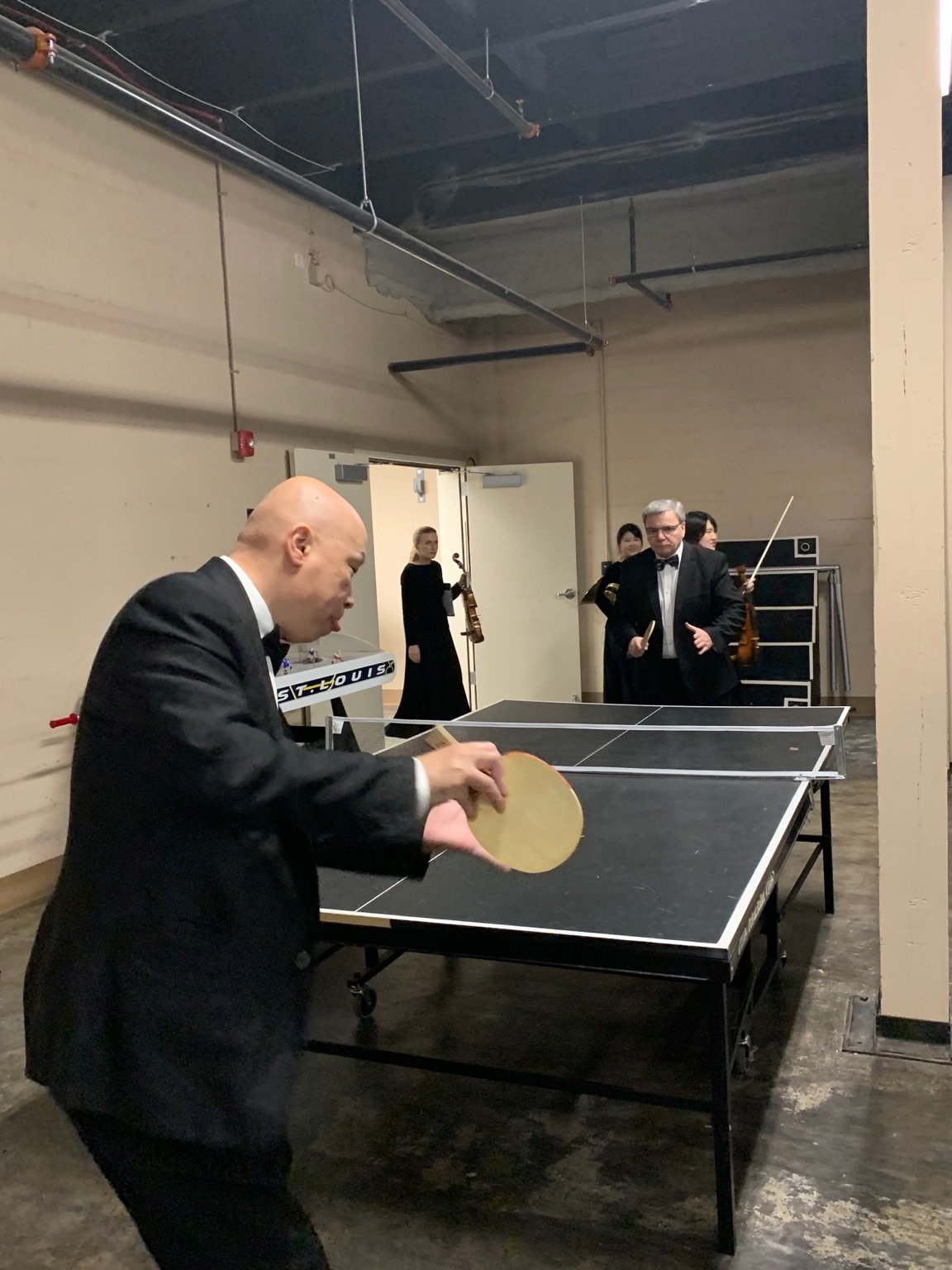
O maestro Milen Nachev, representando a Bulgária, e o contrabaixista Yu Deng, representando o Canto-China, disputam uma partida de pingue-pongue nos bastidores.

Ficou muito intenso lá por um tempo.
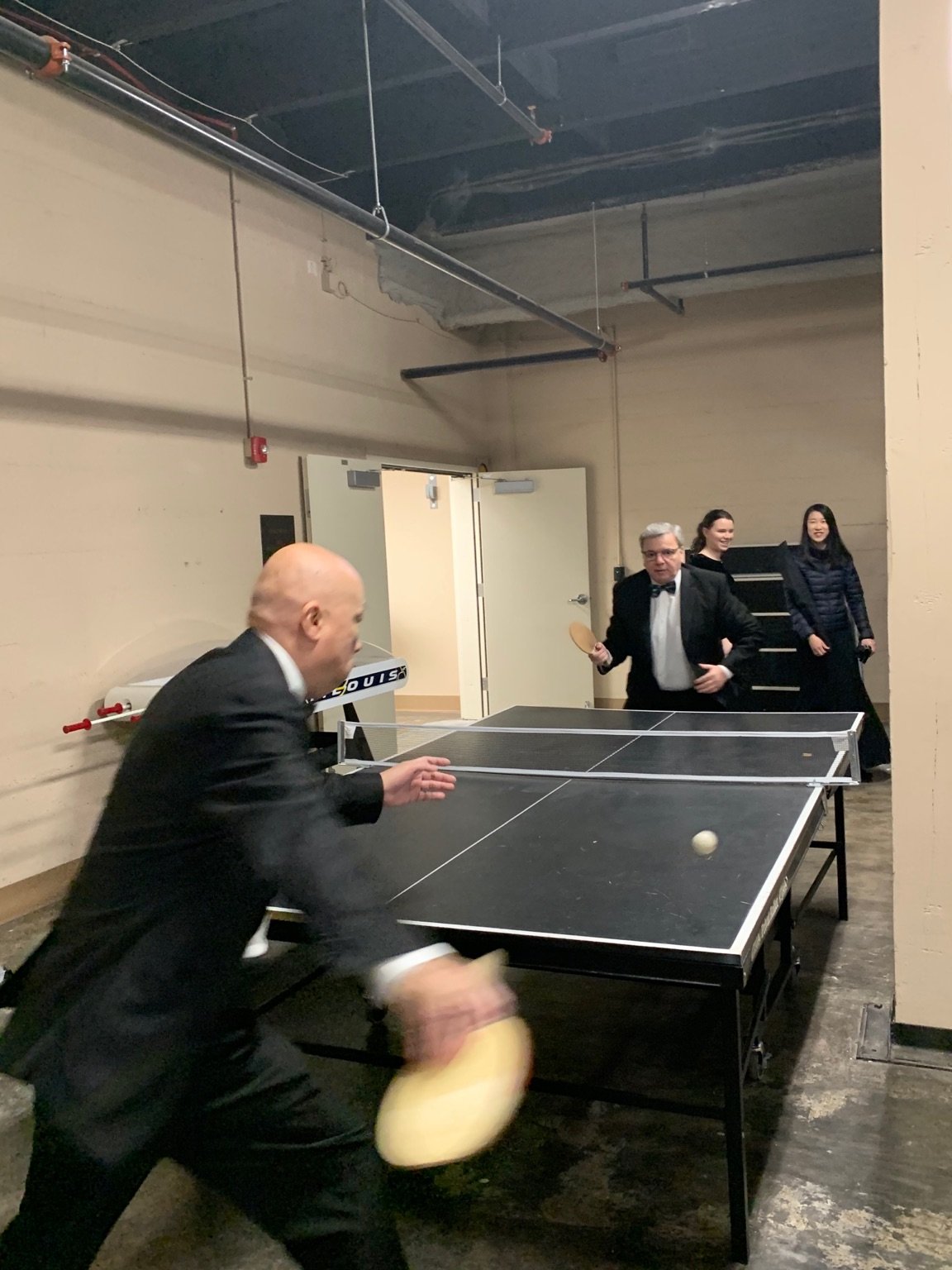
Estes não são alguns dos jogadores de tênis de mesa mais bem vestidos que você já viu?
2 de março: Uma perna feita
Depois de três apresentações em St. Louis, estamos voltando ao norte da fronteira para apresentações em Winnipeg na segunda e terça-feira. É uma longa viagem, então nós dividimos em dois dias. Chegamos em Iowa City na noite passada com tempo suficiente apenas para fazer o check-in, dormir algumas horas e estar no ônibus para que possamos partir novamente às 7h.
Isso não impediu os dançarinos de começarem seu trabalho. Quando a projecionista Regina Dong acordou atordoada entre 5h e 6h (ela ainda não tem certeza de quando, porque é assim em longas viagens) ISSO é o que ela encontrou fora de sua porta:

Esta é a dançarina Zizhen Yu, carinhosamente conhecida como Zhen-zhen, fazendo sua rotina diária de alongamento. E ela parece estar gostando!

3 de março: Feito nos EUA
Shen Yun é de Nova York. Sempre fomos de Nova York. Sempre dissemos que somos de Nova York.
Mas a julgar pelo que alguns meios de comunicação estão dizendo agora, você pensaria que o fato de estarmos dizendo que somos de N.Y. é uma grande notícia. Uma mudança de paradigma. Um pivô de marketing. Uma nova estratégia.
Depois de emitirmos um comunicado à imprensa (link) esclarecendo que o Shen Yun não é da China, os artistas moram nos Estados Unidos e ninguém tem voltado à China há algum tempo, portanto, não temos nada a ver com o Coronavírus, alguns meios de comunicação trataram isso como se fosse uma ruptura com o que sempre dissemos.
Se você não estiver prestando muita atenção, tudo isso pode ser confuso. Eu entendo.
‘Então, deixe-me ver se entendi: Shen Yun é uma performance da cultura chinesa, uma celebração da civilização chinesa, mas você não é da China. Mas os artistas são chineses, mas não chineses-chineses, ou eram chineses-chineses, mas agora são americanos-chineses, ou de Taiwan, que faz parte da cultura chinesa, mas não faz parte da China hoje, e neste show você vê verdadeira cultura chinesa, mas você não pode ver o show na China?'
Sim, certo. É simples.
Esta é a lógica básica:
- A civilização chinesa tem uma história de aproximadamente cinco mil anos.
- A cultura desta civilização foi quase completamente destruída nas últimas sete décadas de governo do Partido Comunista. Algumas tradições superficiais permanecem, mas a essência espiritual se foi.
- O Shen Yun foi estabelecido em Nova York em 2006 com a missão de reviver essa cultura por meio das artes cênicas.
- Os artistas do Shen Yun são em sua maioria chineses étnicos de todo o mundo, incluindo da China.
- Uma vez que eles ingressaram no Shen Yun, eles basicamente não podem voltar para a China como indivíduos.
- O Shen Yun, como companhia, não pode se apresentar na China.
- O Partido Comunista Chinês, por meio de suas “missões diplomáticas”, bem como redes e associações de espionagem, vem tentando sabotar o Shen Yun desde o início e nunca parou realmente.
Nada disso é novo. Temos dito tudo isso desde o início.
No palco, MCs como eu dizem as seguintes falas em—cada— apresentação:
“O Shen Yun está sediado em Nova York. Esses artistas estão entre os melhores dançarinos clássicos chineses do mundo. Eles recebem seu treinamento no Fei Tian College e na Fei Tian Academy of the Arts, com sede em Nova York, onde a dança clássica chinesa é a base de seu treinamento.”
Também dizemos isso:
“A missão do Shen Yun é reviver a cultura tradicional genuína. Infelizmente, você não pode ver uma apresentação como esta na China.”
Em nosso site, figura no primeiro parágrafo da seção Sobre:
“O Shen Yun Performing Arts é a companhia pioneira de dança e música clássica chinesa do mundo. O Shen Yun foi fundado em Nova York em 2006 por artistas chineses de elite. Eles se reuniram com uma visão e paixão compartilhadas—para reviver o mundo perdido da cultura tradicional chinesa e compartilhá-la com todos.”
E nos aprofundamos mais na seção Nossa história.
Por exemplo, abrindo literalmente ao acaso, este folheto de 2013:
“AUTENTICAMENTE CHINÊS, FEITO NA AMÉRICA. Com sede em Nova York, o Shen Yun é uma organização sem fins lucrativos que está revivendo a autêntica cultura chinesa. Hoje, você não pode mais ver um show como o Shen Yun na China.”
Eu poderia continuar com isso por muito tempo. Sempre explicamos isso em entrevistas na TV, rádio, jornais e revistas, por exemplo, e fizemos muito para expor como o regime chinês tem tentado nos impedir exatamente por esse motivo (mais sobre isso em um dia ou dois).
Acontece que com o clima recente da COVID-19 e, mesmo antes disso, um sentimento político anti-China crescente nos EUA, tivemos que enfatizar esse ponto no TUDO EM MAIÚSCULAS. E NEGRITO. Talvez até ROXO.
4 de março: Esperou 10 anos
Depois de um dia e meio dirigindo por mais de 1.600 quilômetros de St. Louis, passando por Minnesota e cruzando a fronteira com o Canadá, chegamos a Winnipeg com bastante neve.
“Já nos apresentamos aqui antes?” alguém perguntou. “Acho que o Shen Yun sim, mas não sei se eu já”, alguém respondeu.
De manhã, no teatro, nosso baixo, Li Xin, pegou sua câmera. “Aqui, olhe para esta foto”, diz ele, “tenho quase certeza de que é este corredor. Eu tiro fotos de todos os locais onde me apresento. Estive aqui há 10 anos”.
Passaram-se 10 anos entre as apresentações do Shen Yun em Winnipeg, capital da província de Manitoba. Ao longo desses anos, o apresentador local, a Associação do Falun Dafa de Winnipeg—que na verdade é apenas algumas pessoas, tentaram várias vezes trazer o Shen Yun de volta. Entre dificuldades de agendamento e disponibilidade, uma década se passou.
Só para dar uma ideia do que mudou no Shen Yun desde a última vez que estivemos aqui: Em 2010, tínhamos três companhias. Agora temos sete. Naquela época, não tínhamos a Orquestra Sinfônica do Shen Yun ou a Loja do Shen Yun. O teatro principal onde ensaiamos em Nova York ainda não tinha sido construído, nem a maioria de nossos escritórios e estúdios de dança. Nossos ônibus coloridos eram totalmente brancos. O maestro Milen Nachev ainda estava a dois anos de se juntar a nós. A maioria dos artistas desse grupo estava terminando o ensino fundamental ou, no máximo, o ensino médio. Eu tinha mais cabelo. Muita coisa mudou.
E, finalmente, eles trouxeram o Shen Yun de volta a Winnipeg. Para uma apresentação.
Voluntários vieram de lugares tão distantes como Toronto para ajudar com o serviço de bufê, venda de ingressos e trabalho nos bastidores.
E os ingressos venderam bem. Eles venderam muito bem. Eles venderam tão bem que, poucas semanas antes da noite de estreia (que eu acho que também é noite de fechamento), perguntaram se poderiam adicionar outro show um dia antes do programado. Apesar do calendário de viagens apertado, o show foi adicionado. Mas a verdadeira dificuldade seria vender rapidamente alguns milhares de ingressos em um mercado relativamente pequeno.
Quando nos preparamos para a primeira apresentação, os apresentadores locais, em toda a sua humildade, nos avisaram se desculpando—isso foi uma adição de última hora, a venda de ingressos não é o que gostaríamos e assim por diante. Mas quando a cortina subiu, a casa parecia bem cheia. Eles fizeram isto.
Temos uma tradição que, após a apresentação final em uma cidade, depois de subirmos ao palco e nos prepararmos para partir, nos reunimos no refeitório para agradecer aos apresentadores e voluntários locais.
Seu representante, e lamento não saber o nome dele (raramente o fazemos), disse: “Muitas pessoas estão esperando que o Shen Yun venha para Winnipeg. Finalmente você chegou. Esperamos não ter que esperar mais dez anos para a próxima vez”.
5 de março: 305
Hoje é 5 de março e é uma data importante de saber.
Cerca de dez anos atrás estávamos nos apresentando em Bruxelas. Eu estava nos bastidores trabalhando no meu laptop quando a gerente da nossa companhia, Vina Lee, entrou.
“Você ouviu? Liang Zhenxing acabou de morrer”, ela me disse em chinês.
Eu ainda não tinha ouvido. Sabia que, de um pequeno grupo de irmãos que se propôs a fazer algo notável, ele era o único ainda vivo. Agora ele também se foi.
Sua história remonta ao início de março de 2002. No nordeste da China, em uma cidade chamada Changchun, a perseguição às pessoas que praticam o Falun Gong (Falun Dafa) estava em seu auge. Três anos após o início da campanha de perseguição do Partido Comunista Chinês, o Falun Dafa não havia sido esmagado. Pelo contrário, enfrentando prisões em massa, tortura generalizada, trabalho forçado e crescentes mortes sob custódia, os praticantes do Falun Gong de toda a China viajaram para a Praça Tiananmen e seguraram faixas com as palavras "Verdade, Compaixão e Tolerância", os princípios da prática. Outros penduraram faixas em árvores, afixaram panfletos ou soltaram balões com mensagens penduradas abaixo deles.
“Falun Dafa é bom”, costumavam dizer. “Pare a perseguição”.
Mas a máquina do Partido Comunista Chinês era implacável. Bem lubrificado por décadas de campanhas semelhantes, mais notavelmente a Revolução Cultural de Mao, o aparato de propaganda produziu história após história tentando ligar o Falun Gong a cada malícia social. No noticiário de todas as noites, as pessoas que praticam o Falun Gong foram descritas como loucas e perigosas. Eles foram demonizados a tal ponto que, se amigos e familiares pegassem seus entes queridos meditando, eles os entregariam à polícia.
Foi então que o grupo de irmãos—Liu Haibo, Liu Chengjun, Lei Ming, Liang Zhenxing—decidiram tentar algo diferente. Em vez de ir à Praça Tiananmen por dez segundos segurando faixas seguido de três anos em um campo de trabalho, eles levariam a mensagem diretamente ao povo. Eles desmascarariam a propaganda do Partido. Eles mostrariam ao povo de Changchun como o Falun Gong é praticado livremente em todo o mundo. Como a “autoimolação” foi encenada. Como todos estavam mentindo.
O plano deles, e a execução dele, é lindamente descrito no artigo de Ethan Gutmann Into Thin Airwaves, que mais tarde se tornou um capítulo em seu livro seminal: The Slaughter.
Eles treinaram e aprenderam sozinhos como escalar postes de telefone, emendar fios e conectar transmissores. E então, na noite de 5 de março de 2002, durante o horário nobre da televisão, enquanto as famílias em Changchun se sentavam para sua dose diária de propaganda estatal, a tela apagou por um segundo. Então, um novo programa apareceu.
Por 50 minutos, o véu da narrativa oficial foi levantado e uma realidade muito diferente foi transmitida por oito canais para mais de um milhão de pessoas. A polícia correu freneticamente tentando descobrir de onde vinha a transmissão. As pessoas se aglomeraram ao redor de aparelhos de TV em lojas de conveniência para assistir. Por 50 minutos, este cantinho da China estava livre.
O pequeno grupo de irmãos sabia o que isso significaria. Eles também sabiam quanto custaria. Um por um, eles foram capturados, torturados e mortos.
A polícia invadiu a casa de Liu Haibo, quebrou seu tornozelo na frente de sua esposa e filho, arrastou-o para a delegacia e o eletrocutou com um bastão elétrico até que ele morreu algumas horas depois.
Liu Chengjun foi baleado na perna enquanto fugia, sentenciado a 19 anos de prisão e morreu de lesões em um ano.
Lei Ming foi capturado na noite da transmissão. Ele foi amarrado a uma cadeira de ferro e torturado. Ele morreu de lesões na coluna três dolorosos anos depois.
E Liang Zhenxing, o líder do pequeno grupo, foi levado a um julgamento encenado e condenado a 19 anos de prisão. Lá ele foi eletrocutado simultaneamente com vários aguilhões de gado e acorrentado por longos períodos de tempo. Em 2010, ele estava emaciado e mal conseguia andar ou falar. Ele faleceu em 1º de maio de 2010.
Eu conheci algumas pessoas de Changchun que conheciam essas pessoas, conheciam suas histórias e como eles eram como homens. Eles chamam a transmissão de 5 de março (3/05) de “305”. Espero que este dia seja lembrado e, um dia, celebrado em toda a China.
A versão abreviada da história acima não chega nem perto de fazer justiça. Para a descrição completa, que é cheia de ação e baseada em entrevistas detalhadas com aquelas pessoas que conheciam o grupo 305, consulte o artigo de Gutmann: Into Thin Airwaves.
6 de março - Dias fáceis
Nossa programação não é tão ruim. Realmente não é. Temos um alongamento um pouco intenso, mas mesmo isso, em comparação (em apenas um momento), não é tão ruim.
Dia 1: Uma viagem de ônibus de 15 horas de Winnipeg, Manitoba, para Edmonton, Alberta.
Dia 2: Preparação pela manhã (deixando o hotel às 5h20 ou 7h15, dependendo da sua função) e trabalhando o dia todo e em uma apresentação noturna. Isso é hoje.
Dia 3: Uma apresentação ao meio-dia (meio-dia?!). Seguido de ataque. Seguido por uma viagem de três horas até Calgary. De alguma forma, há um churrasco coreano preso lá em algum lugar.
Dia 4: Preparação no início da manhã (saída às 7h15 ou 5h20) seguido por um show no início da noite.
Essa é uma amostra de como a vida em turnê pode ser e os desafios que ela apresenta para todos: longas viagens de ônibus, dias longos e novas cidades em dias consecutivos.
Mas, como eu disse, não é tão ruim em comparação.
É muito parecido com a vida da liga secundária de beisebol, por exemplo. E não é tão intenso quanto as Ligas Negras.
Um século atrás, todas as ligas de beisebol afro-americanas tinham uma programação muito mais intensa do que a nossa. Os jogadores costumam jogar um jogo em uma cidade, depois entrar no ônibus e jogar outro jogo em outra cidade no mesmo dia. Às vezes, eles até jogavam uma partida dupla em uma cidade e depois outra partida dupla em outra cidade, ou mesmo duas outras cidades, fazendo aparentemente impossíveis seis jogos em três cidades em um dia.
Nossa programação não é tão intensa quanto a que o famoso tenor Guan Guimin uma vez me disse que sua programação tinha sido. Na década de 1980, o Sr. Guan estava em turnê com uma trupe de artes cênicas. Pessoas em toda a China tinham acabado de sair da Revolução Cultural e estavam sedentas por algum entretenimento. Assim, sua companhia chegava a uma cidade, montava um palco improvisado, tocava por uma ou duas horas e depois dirigia para outra cidade e fazia o mesmo. Não era incomum para eles estarem em cinco cidades em um dia. As apresentações começavam a qualquer hora: shows às 3h00, shows às 5h00, você escolhe. Ele disse que alguns cantores estavam tão atordoados que subiam no palco, esqueciam completamente as letras, murmuravam algo ininteligível e saíam para tomar outra bebida. Então nossa programação não é tão ruim assim.
Nosso cronograma também não é tão árduo quanto a produção clássica, a primeira apresentação atemporal que permaneceu relevante por literalmente meses. Estou falando, é claro, sobre o Baby Shark. A apresentação do Baby Shark Live está em uma cidade diferente a cada dia. Aqui está um exemplo de seu website:
12 de março - Appleton, WI
13 de março - Dubuque, IA
14 de março - Peoria, IL
15 de março - Ralston, NE
16 de março - Sioux Falls, SD
17 de março - Grand Forks, ND
18 de março - Rapid City, SD
19 de março - Colorado Springs, CO…
Nossa viagem é bem tranquila em comparação com a de Tang Sanzang, que caminhou a pé da China para o que hoje é conhecido como Índia (e voltou) em uma jornada que levou 17 anos e inspirou o romance clássico Jornada ao Oeste. Ele nem mesmo tinha o benefício de postos de gasolina Pilot.
Nossa programação é moleza em comparação com a semana infernal da Navy S.E.A.L.S, que consiste basicamente em não dormir, correr carregando objetos pesados, pular para dentro e fora do oceano e ouvir gritos por cinco dias e noites seguidos. E eles não têm milhares de pessoas aplaudindo e torcendo por eles todas as noites.
Nossa programação é uma caminhada no parque em comparação com qualquer soldado na frente de batalha em qualquer época e lugar da história. É uma brisa em comparação com os primeiros respondentes nos dias após um terremoto.
Nossa jornada é muito mais suave do que a de Steve Martin em Antes Só do que Mal Acompanhado, mais colorida do que A Mulher Faz o Homem e faz muito mais sentido do que Cidadão Kane.
Então, o que vou fazer agora é me levantar deste sofá confortável, fazer um lanche e, em seguida, voltar ao trabalho neste teatro aconchegante e agradável no meio de nosso passeio cômodo.
7 de março: Do outro lado do Butter Dome
Neve, neve, em toda parte. Estamos em nosso segundo dia em Edmonton, Alberta.
Edmonton, você ficará feliz em saber, é uma cidade a 1.403 milhas do Pólo Norte. Está apenas 99 milhas do Círculo Polar Ártico. E, como todas as cidades, fica a 0,2 milhas do Starbucks.
Este edifício em frente ao teatro é conhecido localmente como "The Butter Dome".

8 de março: O Jubilee
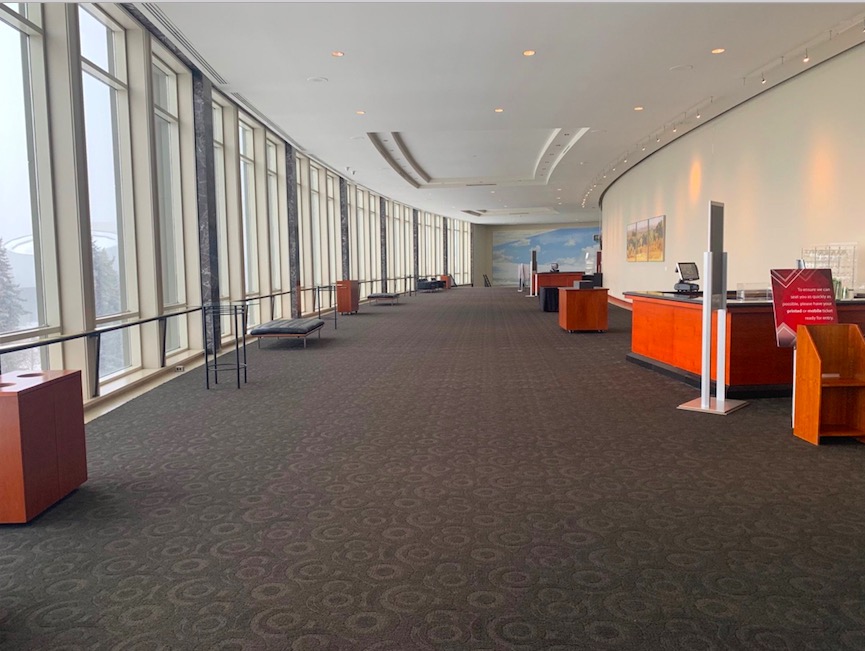
9 de março: Comparar e contrastar
Jubilee de Edmonton:

Jubilee de Calgary:
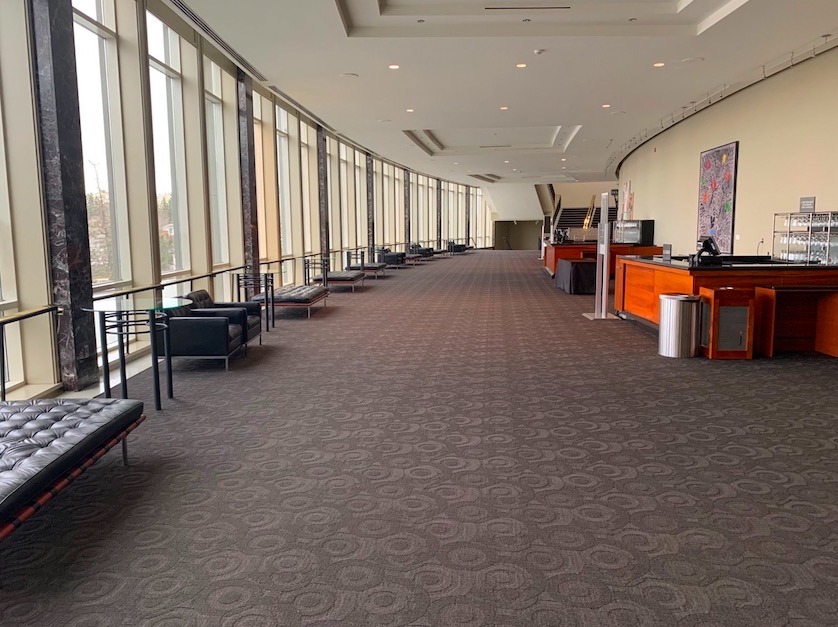
Na manhã em que chegamos em Calgary. Antes que os camarins fossem designados, tudo que eu tinha que fazer era apenas voltar ao palco, seguir a mesma escada, passar pela mesma porta, virar à direita no mesmo corredor e depois à esquerda e entrar no mesmo camarim. Todos os outros fizeram o mesmo. Eu então subi ao palco para olhar o salão. Exatamente como no dia anterior em Edmonton.
NAJA e SAJA. Dois jubilees. Eles são gêmeos idênticos usando macacões, tênis e óculos de sol combinando. É bem legal.
Além disso, os teatros são chamados de Jubilee. Ou o Jube, para resumir.
10 de março: Descubra a diferença
Vamos brincar: identifique as diferenças. Estas fotos são cortesia do dançarino Ben Chen, estrelado pelos dançarinos Bill Xiong e Sean Ren.
Camarim do Jubilee de Edmonton:

Camarim de Calgary:
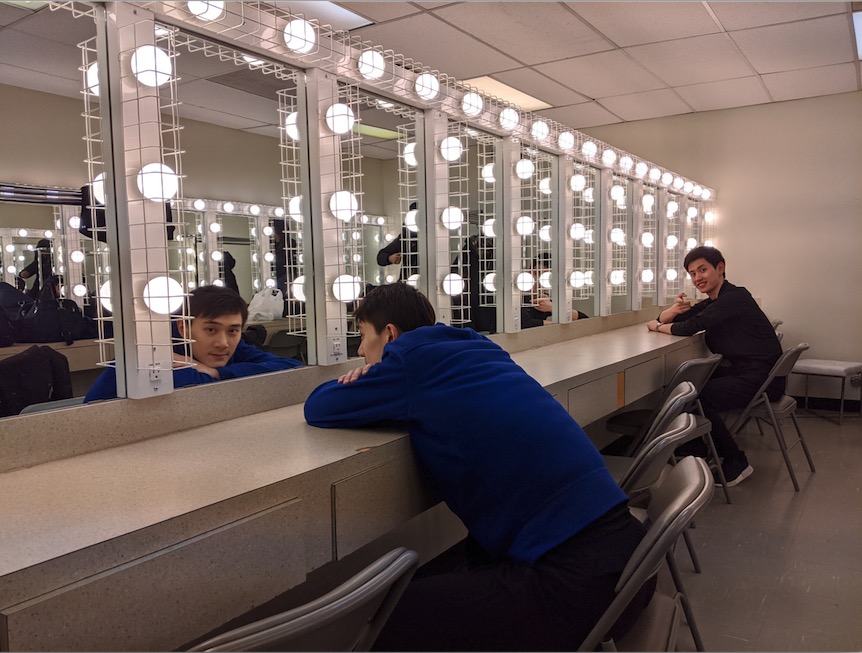
Sala da barra do Jubilee de Edmonton:

Sala da barra de Calgary:

Sala verde de Edmonton:

Sala verde de Calgary:

Doca de Edmonton:

Doca de Calgary:
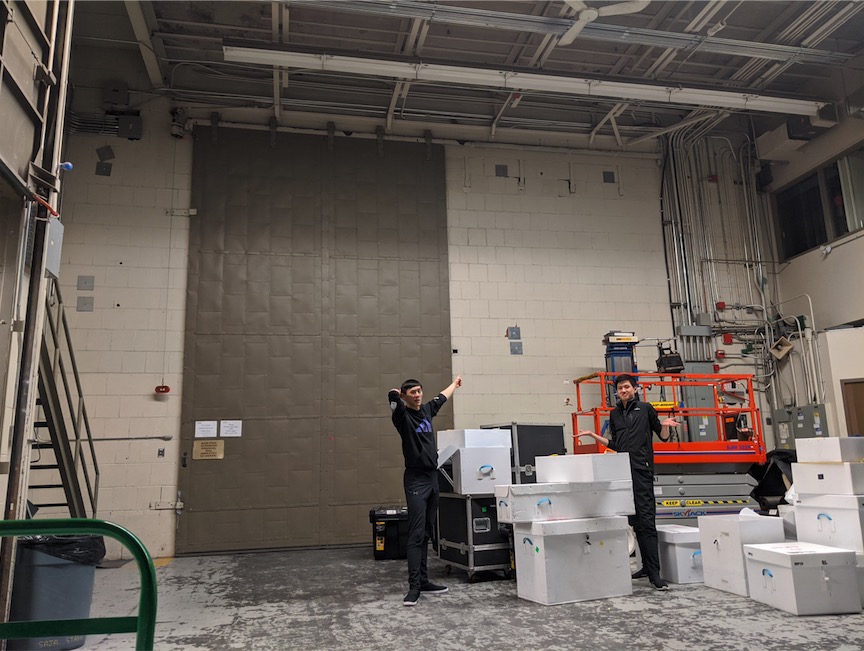
Assentos no nível da orquestra de Edmonton:

Assentos ao nível da orquestra de Calgary:
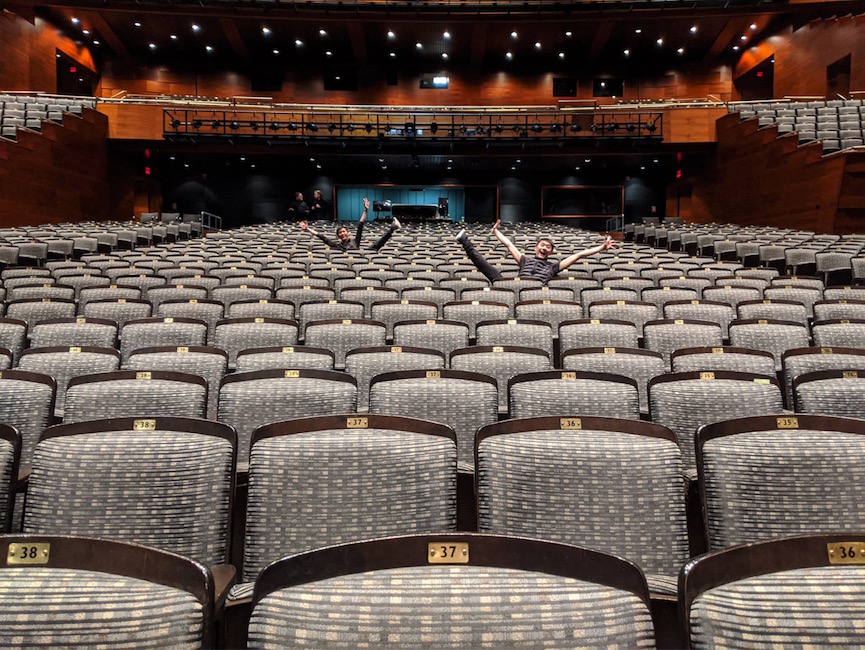
Entrada de Edmonton:

Entrada de Calgary:
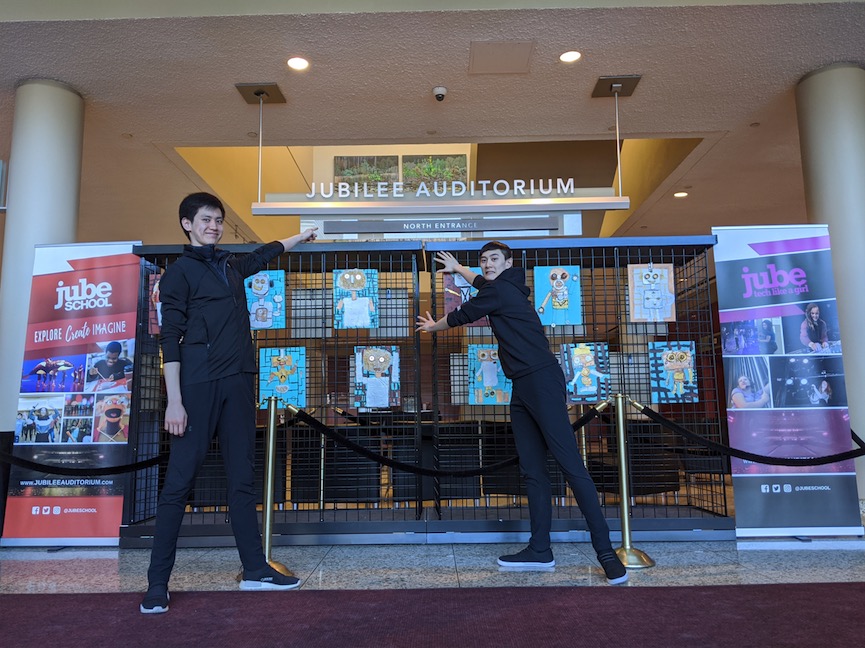
Parede da escada de Edmonton:
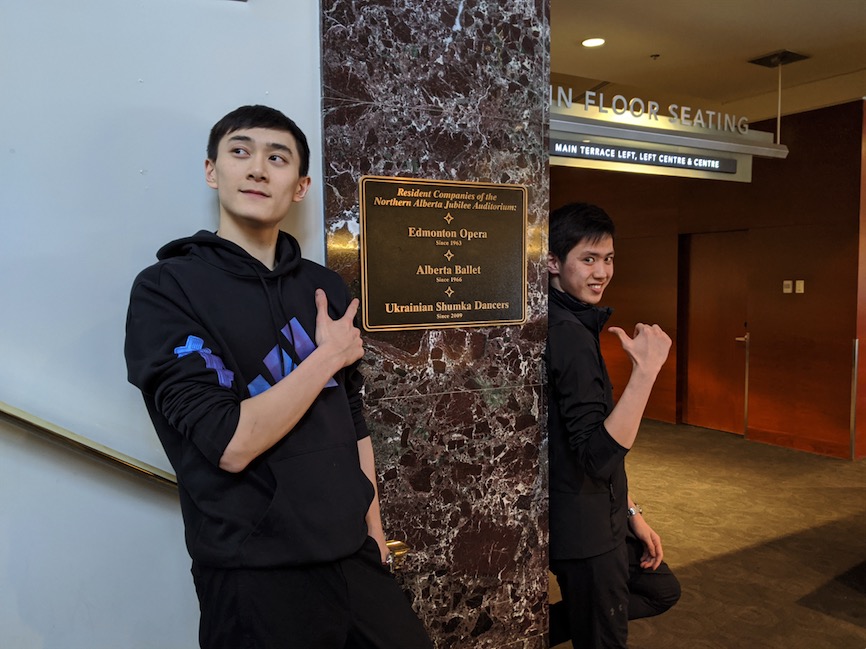
Parede da escada de Calgary:
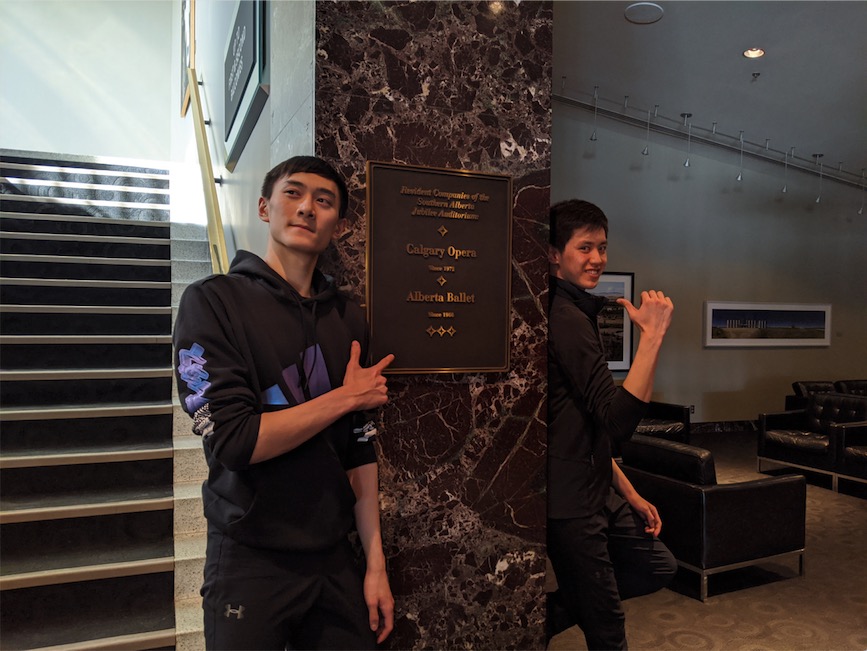
Parede da escada de Calgary—um andar acima. Encontramos uma diferença estrutural!

11 de março: Chapéu Branco
Antes de sair de Calgary para Vancouver, temos uma história para contar.
Era maio de 2007, o final da primeira turnê mundial do Shen Yun. Na época, nem mesmo se chamava Shen Yun em inglês. Foi chamado Divine Performing Arts. Alguns dos dançarinos daquela época ainda estão se apresentando hoje. A blogueira Betty Wang foi uma delas. Assim como a dançarina e coreógrafa Michelle Ren. Estou mencionando ela por um motivo—apenas me dê um segundo.
Muitas coisas estavam em constante mudança naquele primeiro ano, incluindo a ordem do programa e os artistas. Tivemos uma apresentação para a temporada de férias dos EUA, chamada Holiday Wonders, outra apresentação para o Ano Novo Chinês, e mais uma apresentação para a turnê em si.
Porque na época tínhamos apenas um grupo de atuação (sete hoje), realmente fizemos uma turnê turbulenta pelo mundo, cobrindo quatro continentes em seis meses. Começamos nos EUA, fomos para o Canadá, voltamos. Em seguida, voamos para a Europa para a turnê europeia, que naquele ano consistia em duas cidades—Paris e Berlim. De lá, foi para a Ásia, mas não antes de parar "no caminho" em Chicago.
Aquela parada foi agitada, pois no caminho nosso avião foi atingido por um raio. Lembro-me de ver o flash do raio fora da janela, as luzes na cabine instantaneamente se apagam, o som dos motores param, as luzes vermelhas de emergência piscam, o avião faz uma daquelas suspensões de gravidade de montanha-russa onde você paira por um segundo e depois cai enquanto ainda horizontal. Então, as luzes e o ruído do motor voltaram e o vôo continuou. Essa coisa toda demorou cerca de 2 segundos.
Na verdade, provou ser um bom material. Na noite de estreia em Chicago, a parceira MC Zhou Mei e eu subimos ao palco e dissemos:
Leeshai: Senhoras e senhores, bem-vindos! É tão bom estar aqui em Chicago! Principalmente porque, ontem, no caminho de volta, demoramos para entrar em O'Hare, contornamos o lago Michigan cinco vezes e fomos atingidos por um raio.
Mei: O que é um sinal de boa sorte!
Leeshai: Talvez na cultura chinesa…
De Chicago, voamos para o Japão e nos apresentamos lá meio grogue no dia seguinte (ou foi no dia anterior?). Continuamos para a Austrália, Nova Zelândia, Taiwan, Coréia do Sul e então... Calgary.
Em Calgary, fomos recebidos no aeroporto com flores, placas, câmeras e tudo o mais. Só que, desta vez, também havia um representante oficial da cidade para nos cumprimentar.
O vice-presidente executivo do Departamento de Turismo de Calgary, Joe Connelly, em nome do prefeito de Calgary e do governo da cidade, celebrou uma pequena cerimônia.
Primeiro, ele concedeu títulos de cidadão honorário a nossa soprano Feng Ming, ao tenor Guan Guimin e à coreógrafa Vina Lee.
Em seguida, ele emitiu certificados de cidadania honorária e deu a cada homenageado um chapéu de cowboy branco.
Agora, por melhor que seja a Internet em lembrar coisas, foi muito difícil para mim encontrar as notícias daquele bem-vindo. Mas eventualmente eu encontrei. As fotos realmente dão uma ideia de quanto tempo atrás isso aconteceu. Elas não são exatamente preto e branco, mas são definitivamente câmeras pré-iPhone SE 12MP.
Então aqui estão duas fotos. Na primeira, você pode ver todos os artistas do Shen Yun que foram homenageados, embora eu mal consiga distinguir quem é quem (talvez um concurso online divertido?). Na segunda, embora você possa reconhecer Michelle Ren.
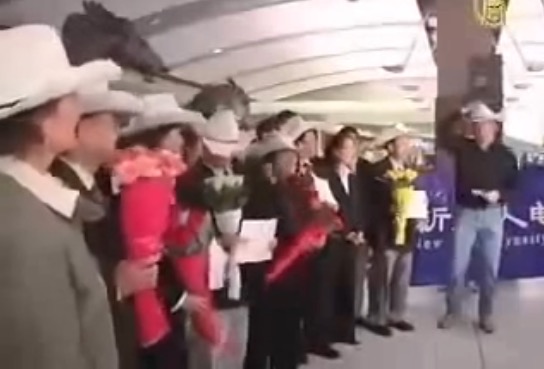

Todos os artistas então se reuniram atrás dos cidadãos honorários que haviam acabado de receber o "chapéu branco" e, seguindo Connelly, olharam para as câmeras, tiraram os chapéus (reais ou imaginários) e gritaram: "Ya-hooooo!".Essa filmagem tem que estar em algum lugar...
12 de março: Última postagem?Estamos em Vancouver. E...Hoje, às 19h30, nosso gerente de produção enviou uma programação para o carregamento de amanhã: 7h45, saída do hotel, início da preparação às 8h, passagem de som às…Às 20h38, ele enviou esta mensagem: "Todos podem, por favor, virem para a sala de alimentação agora?"Cinco minutos depois, recebemos a notícia—os shows de Vancouver foram cancelados. Vamos para casa.O resto da turnê foi cancelado? Não sei.Por causa do vírus? Sim. Todos os eventos públicos da cidade estão encerrados.Que tal irmos para a Europa? Não sei.E quanto aos outros grupos? Não sei.Oh, e o jantar está aqui. Você pode ir comer agora. E embalar lanches para quatro dias na estrada.Então... esta pode ser minha última inserção no blog, pelo menos por agora.
Roteiro Post-Blog
Ainda não tenho certeza do que fazer com isso, ou o que está por vir. Eu sei que estaremos de volta. Espero que seja muito em breve, mas claramente algo grande está acontecendo. Para o desconhecido então...
Eu realmente quero agradecer a todos vocês que seguiram este blog.
Para ser honesto, quando começamos, eu não sabia se alguém gostaria de ler isso. Até parecia um pouco indulgente. Mas seus comentários foram realmente encorajadores. Eles me mostraram que, pelo menos entre os fãs do Shen Yun, as pessoas querem conhecer melhor nossos artistas. Você quer conhecer esses dançarinos e músicos como pessoas, saber como eles são e como é a vida tocando e viajando todos os dias para eles. Há muita alegria no que eles fazem e muita diversão também. Espero que você tenha sido capaz de ver isso nessas histórias por trás das cenas, e eu sei que você pode definitivamente ver isso no palco. É realmente para você que eles se apresentam.
E mal podemos esperar para ver você e nos apresentarmos novamente em breve!
Nesse ínterim, por favor, fiquem seguros e mantenham-se firmes todo mundo!

Leeshai Lemish
Mestre de cerimônias




